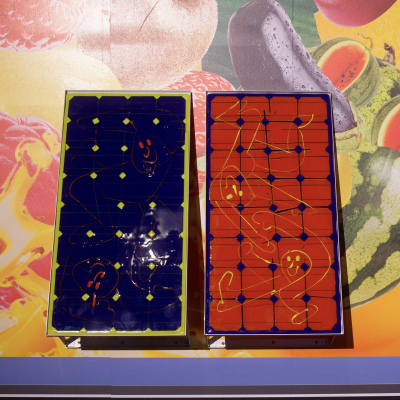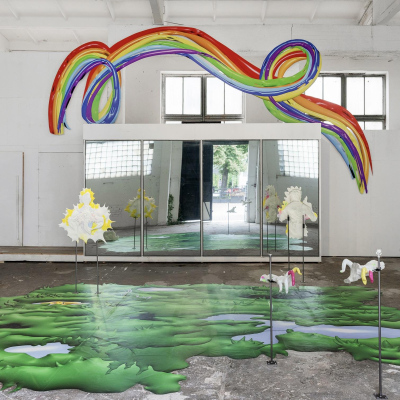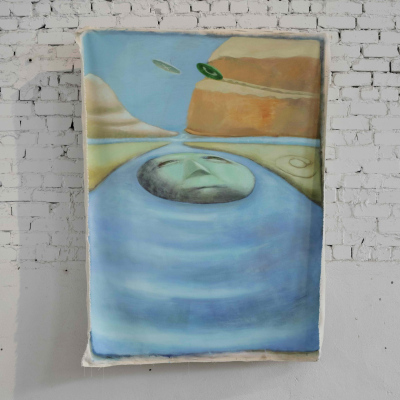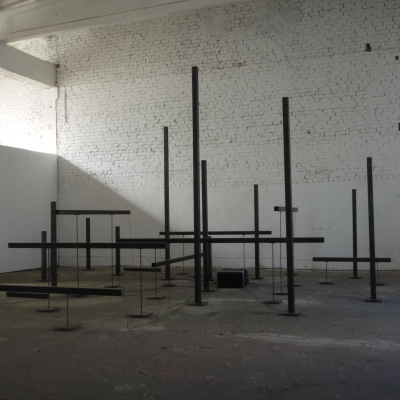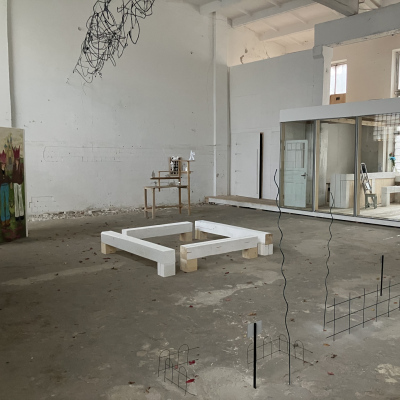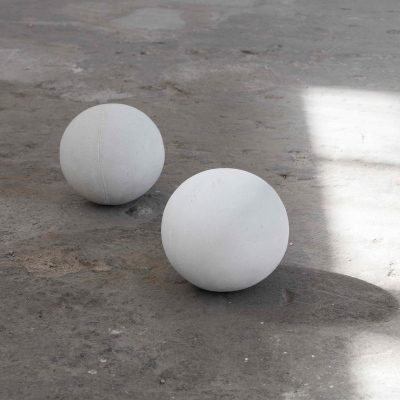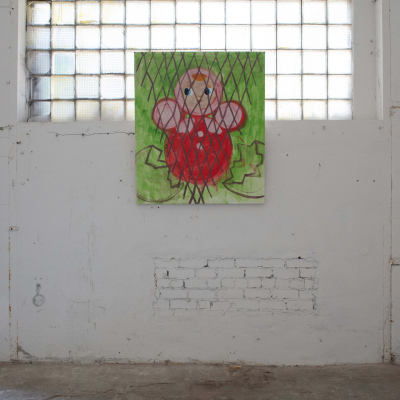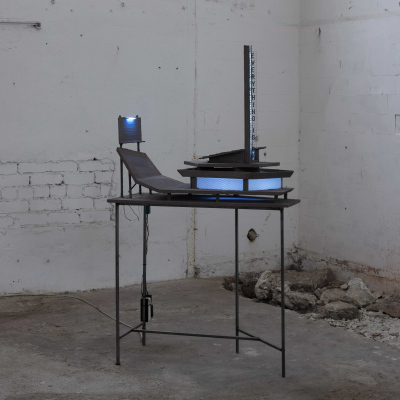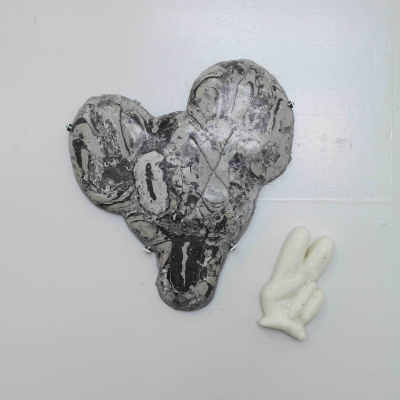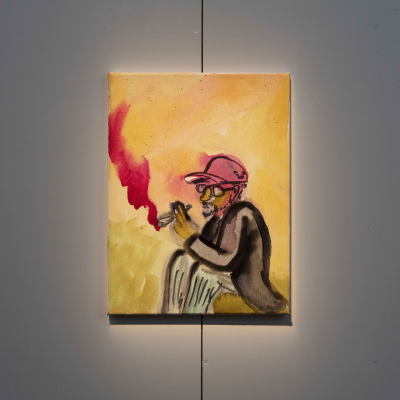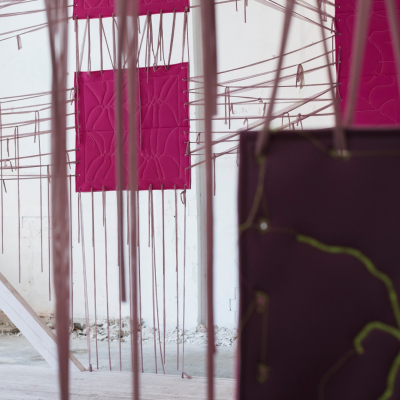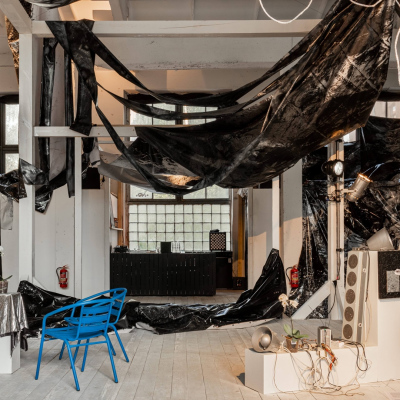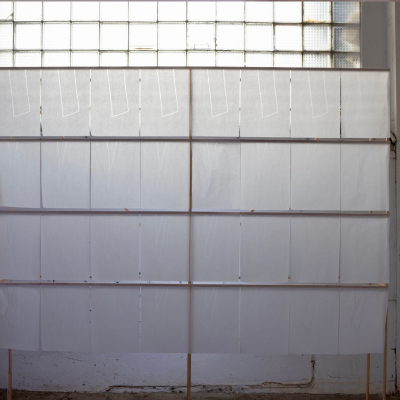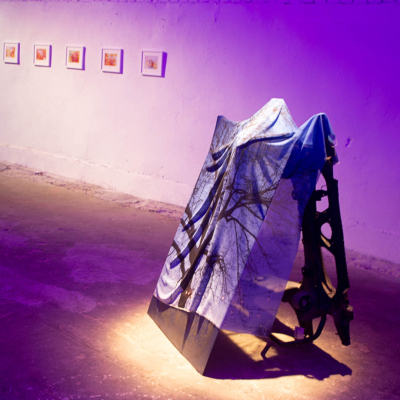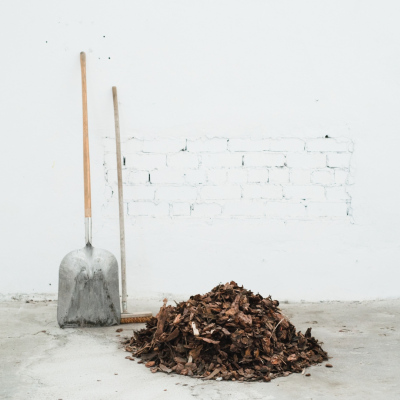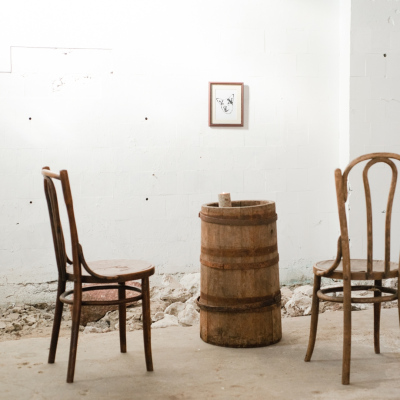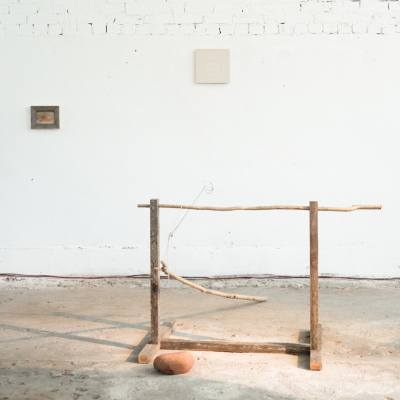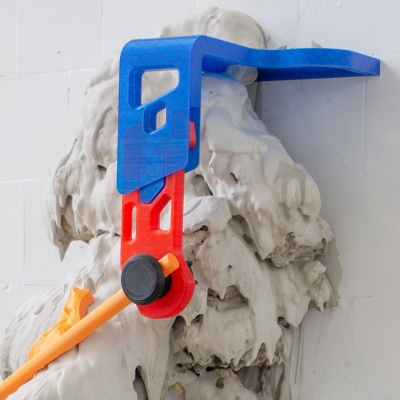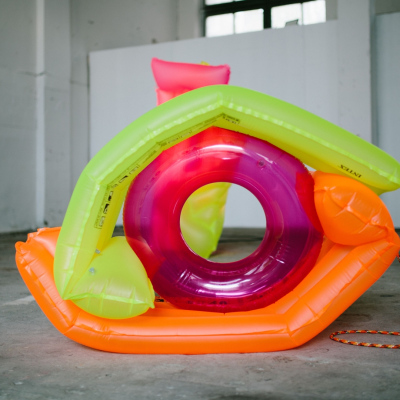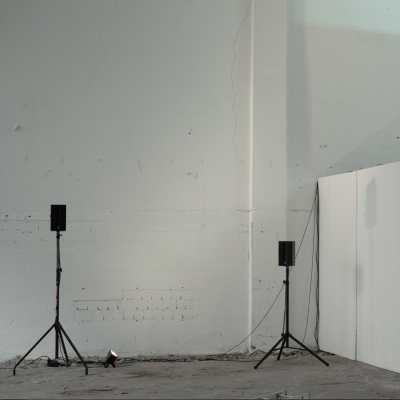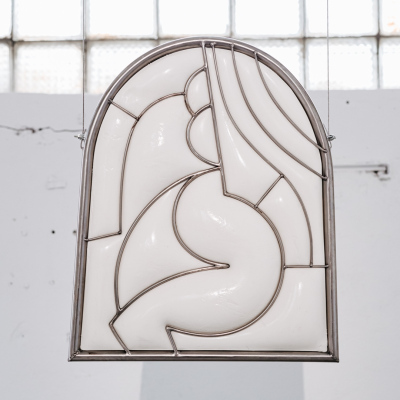Under the Sun
Eric Giraudet de Boudemange
Agnieszka Polska
Līga Spunde
Agate Tūna
29.10 - 29.11.2025
The exhibition Under the Sun began as a conversation between two contemporary art spaces located on either side of Europe: TUR in Riga and 1646 in The Hague. At a time when Europe’s social and political fabric feels increasingly fragile, it becomes necessary to reinforce cultural relationships and deepen mutual understanding through artistic exchange. Art, at its most vital, opens a space to reflect with nuance, to listen closely, and to respond thoughtfully. From this shared belief in the importance of dialogue grew the foundations of this exhibition: a collaboration shaped by four artistic practices and three curatorial visions from two independent art spaces. The exhibition, in its tone and themes, echoes the impulse that initially brought TUR and 1646 together: a desire to engage with the present through art.
The four artists in this exhibition – Eric Giraudet de Boudemange, Agnieszka Polska, Līga Spunde, and Agate Tūna – were invited for the distinct ways their practices engage with the conditions of contemporary life: how we make sense of the world around us, and how we navigate our place within it. Their works explore how we respond to a time shaped by ecological collapse, war on our borders, rising political unease, technological saturation, and a longing for spiritual grounding. The artists are united by a shared attentiveness to the emotional and ethical dimensions of contemporary life, even as their methods and materials diverge. Within the exhibition, their visions come together as an extended layer of perspective that shifts between planetary, psychological, and metaphysical realms, a constellation made up of distinct sensibilities that overlap and diverge. Together, they invite the viewer to reflect not only on what we see, but on how we respond and what forces shape our capacity to remain present, perceptive, and responsive in this liminal time.
In Under the Sun, the works of Eric Giraudet de Boudemange, Agnieszka Polska, Līga Spunde, and Agate Tūna form an entangled universe. Polska’s video The New Sun casts its presence across the exhibition.Its childlike celestial narrator drifting between melancholy and absurdity as it addresses Earth through surreal monologues, love poems, and prophetic warnings. The sun speaks from above, simultaneously witness and participant, offering a poetic lens on crisis, responsibility, and the fragile cycles of life on Earth. Around this work, Giraudet and Tūna each developed new work that extend their ongoing artistic inquiries while responding to the context of TUR and the themes of the exhibition. Giraudet’s installation centres on two monumental truck forms, both sculptural objects and conceptual vehicles. They anchor an allegorical inquiry into movement, extraction, and exchange, forming a framework of objects and references that evoke the systems through which not only goods, but also values and beliefs, are transported across landscapes. Giraudet’s work reflects on how agricultural cycles shape our relationships to labour, nourishment, and survival, offering a layered perspective on the infrastructures that sustain, and strain, contemporary life.
Tūna’s works hover between recognition and speculation, reflecting on how meaning is projected onto the unknown. Abstract fragments of an original image, which she calls “creative parasites,” are fused together and act like visual glitches or digital debris. As their origins dissolve, they become entities in their own right, neither fully legible nor entirely unfamiliar. In these works, Tūna draws on a visual language of satellites, drones, and elusive aerial objects, as if low-resolution images of the sky invite us to guess at what we’re looking at. Amid the exhibition’s planetary and digital trajectories, Spunde’s work draws us back toward the body and what it means to be human. Her work emerges from a world marked by social fragmentation and psychological fatigue, proposing a space to contemplate human virtues such as empathy, resilience, and inner strength from a place of hope, humor and optimism. Through a visual language shaped by contemporary imagery and symbolic form, she explores how emotional gestures might be practiced, rehearsed, and reclaimed. It is an invitation to consider how we embody care, attention, and integrity in uncertain times.
Curated by:
Johan Gustavsson (Co-director 1646)
Clara Pallí Monguilod (Co-director 1646)
Edd Schouten (Artistic Director TUR)
Project Managers: Kristīne Ercika (TUR) and Rianne Zijderveld (1646)
Production Manager: Ada Ruszkiewicz (TUR)
Technical Support: Bas de Boer, Maksimilians Kotovičs and Oto Holgers Ozoliņš
Technical Support Glass Point: Anna Varnase and Kitija Almane
Graphic Design: Andris Kaļiņins (TUR) and Lara Roelofsma (1646)
Documentation: Bob Demper
Transcription translation: Krista Luīze Priedīte
1646 Team:
Martha Gallego, Production
Puck Kroon, Marketing & communication
Lana Mesić, Marketing & communication
Claire The, Audience, education & inclusion
Zem Saules
Ēriks Žīrodē de Būdemanžs
Agņeška Polska
Līga Spunde
Agate Tūna
29.10 - 29.11.2025
Izstādes “Zem saules” aizsākums bija saruna starp divām laikmetīgās mākslas telpām, kas atrodas Eiropas pretējās pusēs: TUR Rīgā un 1646 Hāgā. Laikā, kad Eiropas sociālā un politiskā struktūra kļūst arvien trauslāka, īpaši svarīgi ir stiprināt kultūras saites un padziļināt savstarpējo izpratni caur māksliniecisku apmaiņu. Māksla savā dzīvīgākajā izpausmē rada telpu niansētām pārdomām, ieklausīšanās un sapratnes brīžiem, kā arī pārdomātai reakcijai. No kopīgās pārliecības par dialoga nozīmīgumu izauga šīs izstādes pamati. Tā ir sadarbība, ko veido četras mākslinieciskās prakses un trīs kuratoriālie skatījumi no divām neatkarīgām mākslas telpām.Vēlme domāt par tagadni mākslas valodā bija sākotnējais impulss, kas satuvināja TUR un 1646, un tieši to atspoguļo izstādes noskaņa un tematika.
Četri izstādes mākslinieki Ēriks Žīrodē de Būdemanžs, Agņeška Polska, Līga Spunde un Agate Tūna tika uzaicināti, pateicoties katra mākslinieka individuālajam skatījumam uz mūsdienu dzīves nosacījumiem, uz to, kā mēs izprotam pasauli sev apkārt un kā tajā atrodam savu vietu. Mākslinieku darbi pēta mūsu reakciju uz laiku, kuru iezīmē ekoloģiskā sabrukuma ēna, karš pie robežām, pieaugošā politiskā spriedze, tehnoloģiskā pārbagātība un ilgošanās pēc garīgas stabilitātes. Māksliniekus vieno jutīga attieksme pret mūsdienu dzīves emocionālajiem un ētiskajiem slāņiem, pat ja viņu metodes un materiāli ir atšķirīgi. Izstādes ietvaros viņu skatījumi savijas paplašinātā perspektīvu laukā, kas mainās starp planētu, psiholoģiskām un metafiziskām dimensijām, veidojot kopumu no skatījumiem, kas vietām saplūst un vietām nošķiras. Kopā viņi aicina skatītāju pārdomāt ne tikai to, ko mēs redzam, bet arī to, kā mēs reaģējam un kādi spēki ietekmē mūsu spēju palikt klātesošiem, vērīgiem un atsaucīgiem šajā pārmaiņu laikā.
Izstādē “Zem saules” Ērika Žīrodē de Būdemanža, Agņieškas Polskas, Līgas Spundes un Agates Tūnas darbi veido savstarpēji savītu visumu. Polskas video darbs The New Sun (“Jaunā saule”) piepilda izstādes telpu ar savu klātbūtni. Tā bērnišķīgais debesu stāstītājs, balansējot starp melanholiju un absurdu, uzrunā Zemi sirreālos monologos, mīlas dzejoļos un pravietojumos. Saule runā no augšas, vienlaikus kā lieciniece un dalībniece, piedāvājot poētisku skatījumu uz krīzi, atbildību un trauslajiem dzīves cikliem uz Zemes. The New Sun kalpojis kā impulss Žirodē de Būdemanžam un Tūnai radīt jaunus darbus, kas vienlaikus turpina viņu ilgstošo māksliniecisko izpēti un reaģē uz TUR kontekstu un izstādes tēmām. Žirodē de Būdemanža instalācijas centrā ir divas monumentālas kravas automašīnu formas, kas funkcionē gan kā skulpturāli objekti, gan kā konceptai transportlīdzekļi. Tās atklāj alegorisku skatījumu uz kustību, ieguvi un apmaiņu, uzsverot, ka pāri ainavām tiek pārvietotas ne vien preces, bet arī vērtības un uzskati. Žirodē de Būdemanža darbs atspoguļo, kā lauksaimniecības cikli veido mūsu attiecības ar darbu, uzturu un izdzīvošanu, piedāvājot daudzslāņainu skatījumu uz infrastruktūrām, kas vienlaikus uztur un noslogo mūsdienu dzīvi.
Tūnas darbi atrodas starp atpazīstamo un spekulatīvo, atspoguļojot, kā nozīme tiek projicēta uz nezināmo. Abstrakti sākotnējā attēla fragmenti, kurus māksliniece dēvē par “radošiem parazītiem”, tiek sapludināti vienotās formās un uzvedas kā vizuāli traucējumi vai digitālās atliekas. Izplūstot to izcelsmei, šie veidojumi kļūst par patstāvīgām vienībām, ne pilnībā nolasāmām, tomēr arī ne svešām. Savos darbos Tūna izmanto vizuālu valodu, ko veido satelīti, droni un nenotverami debesu objekti, it kā zemas izšķirtspējas debesu attēli aicinātu skatītāju minēt, uz ko viņš patiesībā raugās. Planētu un digitālo trajektoriju krustpunktā Spundes darbs mūs atgriež pie ķermeņa un jautājuma par to, ko nozīmē būt cilvēkam. Viņas prakse attīstās pasaulē, kuru iezīmē sociāla sadrumstalotība un psiholoģisks nogurums. Tā piedāvā telpu pārdomām par cilvēciskajiem tikumiem, piemēram, empātiju, izturību un iekšējo spēku, raugoties uz tiem ar cerību, humoru un optimismu. Izmantojot vizuālu valodu, kas veidota no laikmetīgiem tēliem un simboliskām formām, Spunde pēta, kā emocionālos žestus iespējams praktizēt, atkārtot un atgūt. Tas ir aicinājums pārdomāt, kā mēs iemiesojam rūpes, uzmanību un godīgumu šajos nenoteiktajos laikos.
Kuratori:
Johans Gustavsons (Johan Gustavsson, 1646 līdzdirektors)
Klara Palī Mongiloda (Clara Pallí Monguilod, 1646 līdzdirektore)
Edvards Shautens (Edd Schouten, TUR mākslinieciskais direktors)
Projekta vadītāji: Kristīne Ercika (TUR) un Rijanna Zeidervelda (Rianne Zijderveld, 1646)
Producente: Ada Ruškeviča (Ada Ruszkiewicz, TUR)
Tehniskais atbalsts: Bass de Būrs (Bas de Boer), Maksimilians Kotovičs un Oto Holgers Ozoliņš
Tehniskais atbalsts Glass Point: Anna Varnase un Kitija Almane
Grafiskais dizains: Andris Kaļiņins (TUR) un Lara Rūlofsma (Lara Roelofsma, 1646)
Dokumentācija (Documentation): Bobs Dempers (Bob Demper)
Transkripta tulkojums: Krista Luīze Priedīte
1646 komanda:
Marta Galjego (Martha Gallego), Paka Krūna (Puck Kroon), Lana Mesiča (Lana Mesić) un Klēra The (Claire The)
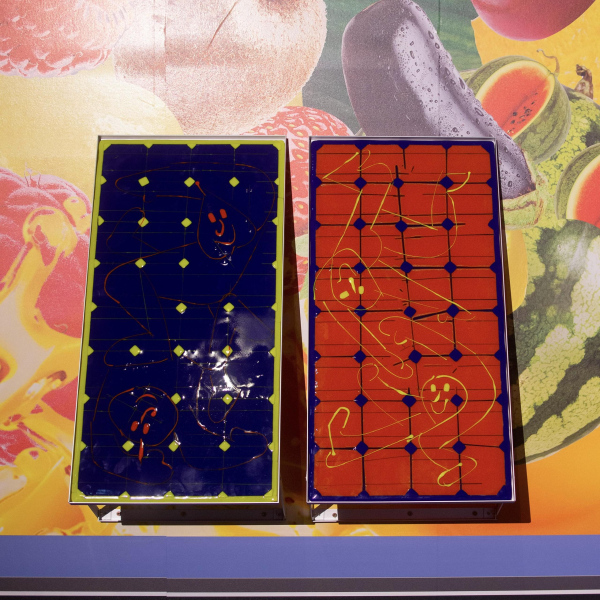
Līga Spunde
Vingrinājumu lauks
20.08 - 20.09.2026
Līga Spunde pārvērš TUR telpu vingrinājumu laukā - abstraktā treniņu vietā, kur skulpturāli objekti aicina apmeklētājus izmēģināt cilvēciskās vērtības. Monumentālās, 3D drukātās formas iemieso apskāvienu, savijušās rokas vai pārliecības pilnu stāju, raisot spēka, empātijas, maiguma un rūpju sajūtu. Šie priekšmeti nav domāti fiziskiem treniņiem, bet gan iztēles vingrinājumiem un atgādinājumiem par neatņemamām kustībām, kas veido mūsu kopīgo cilvēcību. “Vingrinājumu lauks” veidojas uz pasaules fona, kas kļūst arvien grūtāk pārvaldāma, to ietekmē autoritāras politikas, ekoloģiskais sabrukums un nekaunīgi izcīnīti kari. Spunde savā izstādē piedāvā precīzu un klusi radikālu pretgājienu: iemācīties atkal ticēt vienkāršiem žestiem un atgriezties pie ķermeņa kā izturības avota. Darbi nepiedāva gatavus risinājumus, bet atver telpu iztēlei, mēģinājumiem un sadzīšanai. Tie rosina uz mirkli apstāties, pašreflektēt un pārdomāt žestus, kas uztur cilvēcību mūsos. Šajā vingrinājumu laukā izkaisīti arī vairāki mazāki, gandrīz nemanāmi skulpturāli elementi, kas mudina vingrināt citu praksi - iet lēni, ar nodomu un klātbūtni, praktizējot apzinātību kā cilvēcisku prasmi.
Spunde ir pazīstama ar savām rūpīgi izstrādātajām instalācijām, kurās kinematogrāfisku kompozīciju digitālās drukas, bieži apvienotas ar skulpturāliem elementiem, saplūst, lai izpētītu, kā personiskā uztvere saduras ar kolektīvām struktūrām. “Vingrinājumu laukā” viņa attālinās no sev raksturīgā digitālo zīmējumu izmantojuma un pievēršas skulpturālai formai, drosmīgi eksperimentējot ar lielformāta 3D drukas iespējām. Šīs pārmaiņas nav tikai tehniskas, bet arī konceptuālas. Mākslinieces iepriekšējie darbi bieži vien pievērsās tādām tēmām kā psiholoģiskais sabrukums, digitālā pārslodze un emocionālā disonanse, bet “Vingrinājumu lauks” pēta emocionālās atveseļošanās iespējamību.
Katra skulptūra darbojas kā atvērta instrukcija – tā norāda uz ķermenisku līdzdalību, taču to nepieprasa, vienlaikus saglabājot precīza un patstāvīga mākslas objekta statusu. Darbos skan atbalsis no fizioterapijas praksēm, piemēram, spoguļterapijas, kur veselas rokas tēls palīdz atjaunot ievainoto. Spunde jautā, vai emocionālas paralīzes brīžos mēs nevarētu līdzīgi atkārtot ticības žestus, līdz tie kļūst par mūsu pašu kustībām.
Šajā iecerē ir vieglums, kas pietuvojas bērnišķīgai atklātībai, taču nekļūst naivs. Šī sirsnība ir apzināta un precīza. Laikā, kad bieži dominē ironija un nogurums, “Vingrinājumu lauks” piedāvā negaidīti pretestīgu žestu – telpu, kurā trenēt spēju just. Ne tāpēc, ka just būtu viegli, bet tāpēc, ka tas ir kļuvis grūti - un neatliekami nepieciešami.
Instalāciju pavada skaņa. Nepārtraukta Kārļa Tones kompozīcija dalās telpā ar skulpturālajiem darbiem, savijot akustiskās un elektroniskās tekstūras - maigas un iekļaujošas, spēcīgas, taču saudzīgas. Viņa iedvesmas avoti sniedzas no Sibēliusa un Vāgnera romantiskajiem motīviem līdz sporta zāļu mūzikas enerģiskajam pulsējumam un tiešsaistes pašpalīdzības kanālu meditatīvajām noskaņām. Skaņu ainava nav fons, bet gan atmosfēra, kas ietver apmeklētājus laukā, kur kustība, tēls un skaņa saplūst kā vingrinājumu laukā.
Izstādes kurators un teksta autors: Edvards Shautens (Edd Schouten)
Projekta vadītāja: Kristīne Ercika
Producente: Ada Ruškevica (Ada Ruszkiewicz)
Tehniskais atbalsts: Oto Holgers Ozoliņš, Mārtiņš Skuja, Dāvids Šilters (David Schilter) un Maksimilians Kotovičs
Skaņas dizains: Kārlis Tone
Grafiskais dizains: Andris Kaļiņins
Praktikante: Anita Dille
Izstādi atbalsta: Valsts kultūrkapitāla fonds un Rīgas domes Izglītības, Kultūras un Sporta departaments
Field of Exercises
20.08 - 20.09.2026
Līga Spunde has transformed the space of TUR into a field of exercises: an abstract training ground where sculptural objects invite the visitor to rehearse human virtues. These large-scale 3D-printed forms take the shape of gestures – an embrace, interlocked hands, a stance of confidence – that evoke a sense of strength, empathy, tenderness, and care. They are not props for literal exercise, but propositions for the imagination: reminders of the irreducible movements that define our shared humanity. This conceptual field emerges against the backdrop of a world that feels increasingly ungovernable, shaped by authoritarian politics, ecological collapse, and wars waged with impunity. Spunde counters with a precise and quietly radical proposal: to rehearse belief in simple gestures, to return to the body as a site of resilience. The works do not offer solutions, but they open a space for rehearsal, for practicing the possibility of repair. They encourage a moment of self-recognition, a pause to reflect on the gestures that sustain our humanity. Scattered around the field of exercises are several smaller, almost imperceptible sculptures that invite a different discipline, to walk slowly with intention and engagement. To practice mindfulness as a human discipline.
Spunde is known for her meticulously constructed installations in which digital prints of cinematic compositions, often combined with sculptural elements, converge to examine how personal perception collides with collective structures. In Field of Exercises she departs from her signature use of the flat image and ventures into sculptural form, experimenting with the possibilities of large-scale 3D printing. This shift is not merely technical but conceptual. Where earlier works explored digital overload, psychological fracture, and emotional dissonance, here she turns toward the fragile prospect of recovery. Each sculpture operates as an open instruction, hinting at bodily participation without demanding it, while remaining a precise formal object in its own right. Echoes of physiotherapeutic practice, such as mirror therapy, where the image of a healthy limb helps repair a damaged one, reverberate through the work. She asks whether, in the face of emotional paralysis, we might similarly perform gestures of belief until they take root. There is a lightness in this premise, a tone that edges toward the childlike without ever becoming naïve. The sincerity is deliberate and exacting. In a cultural moment dominated by irony and fatigue, Field of Exercises proposes something disarmingly subversive: a space in which to practice feeling. Not because feeling is easy, but because it has become difficult, and urgently necessary.
The installation is also shaped by sound. A continuous composition by Kārlis Tone shares the space with the sculptural works, blending acoustic and electronic textures – tender and inclusive, strong yet kind. Influences range from the romantic motifs of Sibelius and Wagner to the energising pulse of gym music and the meditative atmospheres of online mindfulness channels. The soundscape is not backdrop but atmosphere, enveloping visitors in a field where movement, image, and sound converge in rehearsal.
Exhibition Curator and text: Edd Schouten
Project Manager: Kristīne Ercika
Production Manager: Ada Ruszkiewicz
Technical Support: Oto Holgers Ozoliņš, Mārtiņš Skuja, David Schilter and Maksimilians Kotovičs
Sound Design: Kārlis Tone
Graphic Design: Andris Kaļiņins
Intern: Anita Dille
Supported by State Culture Capital Foundation and Education, Culture, and Sports Department of Riga City Council
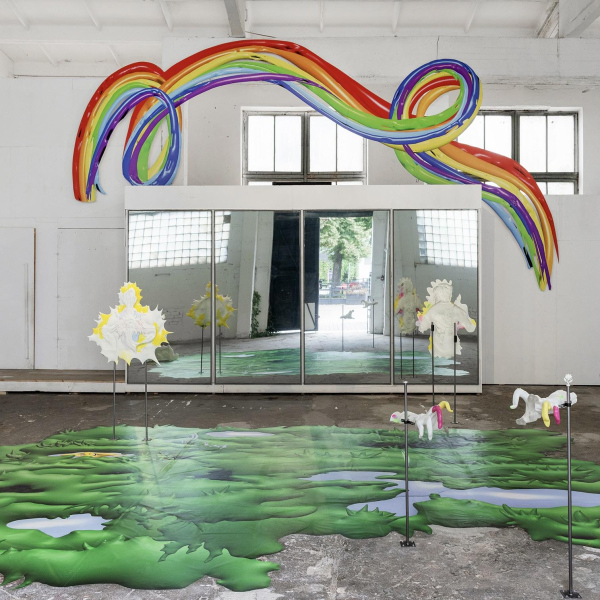
Katrīna Biksone
Aizņemtās līnijas anatomija
10.07 - 10.09.2025
Katrīnas Biksones instalācija "Aizņemtās līnijas anatomija" ielūdz apmeklētājus viegli dezorientējošā telpā, kas izriet no mākslinieces uztveres par hipersavienotības radīto spiedienu mūsdienu pasaulē. Instalācija, kuras centrā atrodas sešas kabīnēm līdzīgas telpas ir visaptveroša un noskaņu veidojoša. Izmantojot glezniecību kā galveno mediju līdztekus skulpturālām intervencēm, Biksone TUR telpu veido kā vidi, kurā uzmanība viegli aizslīd, savienojumi pārtrūkst, un ierastie saziņas ritmi kļūst par pārdomu objektu. Šī klusā, atmosfēriski uzlādētā telpa atgādina par ikdienišķo kaulēšanos starp klātbūtni un prombūtni, uzmanību un atkāpšanos – par tām smalkajām pretrunu niansēm, kur pastāvīga sasniedzamība kļuvusi par normu.
Kā gleznotāja Katrīna Biksone strādā ciešā saskarē ar materiālu – starp tā pretestību un piekāpību. Viņas gleznas top slāni pa slānim, virsmas tiek apstrādātas līdz brīdim, līdz tajās atklājas stāstošums. Formas ir mainīgas, bieži vien tikai nojaušamas, nevis skaidri nolasāmas, radot krustpunktus, kur tēls saplūst ar abstrakciju un otrādāk. Šīs formas nav tikai vizualizācijas vai attēli, bet drīzāk telpas – vietas, kur apstājas uzmanība, sabiezē klātbūtne, un klīst domas. Šī pieeja caurvij arī izstādi “Aizņemtās līnijas anatomija”. Tā balstīta gleznotājas izjūtā par telpu, apskatot gleznas un pašu glezniecību kā daļu no vienota kopuma. Ietekmējoties no tādām autorēm kā Džeina Beneta (Jane Bennett) un Kārena Barada (Karen Barad), Biksone uzlūko materiālu kā līdzvērtīgu partneri. Pigments, audums, ģipškartons, filcs – katrs no tiem piedalās procesā, pretojas, maina virzienu, piedāvā savu procesa attīstības gaitu. Gleznas virsma var strauji pārvērst sākotnējos nodomus, skulpturāls elements – nemanāmi izmainīt telpas noskaņu. Šie klusinātie žesti Biksones prakses kontekstā kalpo drīzāk kā metaforas. Tie materializējas un reizēmpastāv arī paši par sevi – atklājoties nesteidzīgi un negaidīti, bet vienmēr organiski. Šie neuzbāzīgie, klusinātie iejaukšanās brīži nav dramatizēti un necenšas kļūt par simboliem. Tie atklājas nesteidzīgi, ļaujot skatītāja uztverei nosēsties tur, kur tā vēlas.
Instalācijā atkārtoti parādās figūra – Runātājs. Tā forma atgādina cilvēku, tomēr nav precīzi nolasāma. Drīzāk tā radīta tā, lai būtu uztaustāma un tikai asociatīvi atpazīstama. Runātājs joprojām paliek nosacīti svešs – kā būtne, kuras klātbūtne ir sarežģīti definējama. Tās nekustīgums liecina par novērojumu bez vērtējuma. Runātājs nestāsta vai nemēģina ieskaidrot, bet uzturas telpākā pieklusināts liecinieks – piefiksējot uzmanības straumes plūšanas virzienus un vadoties cauri ekspozīcijai. Elpojot kopā ar skatītāju, Runātājs nepiedāvā virzienu, bet gan klusu, fonā esošu līdzāsbūšanu – vērīgu, jutīgu pret telpas stimulētajām fokusa un emocionālo nianšu svārstībām un maiņām.
Izstādi caurvij drīzāk iztēles radīta, nevis vienīgi atmiņās balstīta nostalģijas sajūta Tā virmo gaisā un kļūst jūtama rāmajā, nedalītajā uzmanībā, ko tai velta Runātājs.Šī nostaļģija ir ilgas pēc laika kad nebija patstāvīga savienojuma klātesamības,un uzmanība nebija tik sašķelta. Pašreizējai paaudzei, pagātne vairs nesniedz mierinājumu, bet nākotne iezīmējas ar nenovēršamas lejupslīdes sajūtu, ko pavada bezpalīdzības sajūta tās priekšā. Runātājs neviļus klusībā iemieso šo nostāju. Viņa forma kalpo kā projekcija vai mēģinājums izprast. Viņš neiejaucas, tikai vēro un klausās. Šajā klusajā atturībā atbalsojas veselas paaudzes noskaņojums, ko raksturo cerīga spēja pieņemt, kas turas spēkā arī tad, kad ticība sāk svārstīties.
"Aizņemtās līnijas anatomijas" radītajā atmosfērā instalācijas arhitektūra nepiedāvā izbēgšanu, bet gan novērojošu daudznozīmību – vietu, kur klātbūtne ir sajūtama, bet neko nepieprasa, un uzmanība var klīst bez sekām. Instalācijas telpiskais ietvars atspoguļo Biksones ilgstošo interesi par “ne-vietas” jēdzienu – terminu, ko ieviesis antropologs Marks Ožē, aprakstot pārejas zonas, piemēram, uzgaidāmās telpas vai viesnīcu foajē. Tās ir vietas, caur kurām pārvietojamies, neveidojot identitātes saikni, un tomēr tās ir emocionāli piesātinātas. Biksone šo jēdzienu pārvērš, sajaucot mājīgu un publisku telpu valodu, veidojot vidi, kas vienlaikus šķiet gan pazīstama, gan abstrakta Katra no šīm telpām kalpo nevis kā simboliska vieta konkrētiem notikumiem, bet drīzāk kā noskaņas iniciators. Tās netiek izskaidrotas, bet skatītājs tiek aicināts tās pieredzēt. Tās ir telpas, kas sevī glabā sajūtu, nevis darbību.
Izstādes kurators un teksta autors: Edvards Shautens (Edd Schouten)
Tulkojums: Katrīna Biksone
Projekta vadītāja: Kristīne Ercika
Producente: Ada Ruškevica (Ada Ruszkiewicz)
Tehniskais atbalsts: Oto Holgers Ozoliņš un Maksimilians Kotovičs
Grafiskais dizains: Andris Kaļiņins
Izstādi atbalsta: Valsts kultūrkapitāla fonds
Anatomy of a Busy Line
10.07 - 10.09.2025
Katrīna Biksone’s Anatomy of a Busy Line invites visitors into a gently disorienting space that is shaped by her perception of the pressures of hyperconnectivity in a contemporary world. The installation, largely composed of six cubicle-like spaces, is ambient, more atmosphere than statement. Primarily through painting, accompanied by sculptural interventions, Biksone composes an environment in TUR where attention slips, connection falters, and the familiar routines of contact are rendered open to reflection. These quiet spaces evoke the small negotiations between presence and absence, attention and retreat, that characterize life in a world where being reachable has become a baseline condition.
As a painter, Biksone works through material resistance and openness. Her canvases emerge through layered revision, marks laid down and removed, gestures adjusted, surfaces pushed until something begins to speak. Forms blur and suggest rather than state, creating tonal fields where image and abstraction fold into one another. What results is a painterly space that feels spatial, not illustrative: an active site of attention, density, and drift. That same logic animates Anatomy of a Busy Line. The installation is composed with a painter’s intuition and behaves like a painting in three dimensions, unfolding slowly, perceptively, and without didactic force. Influenced by thinkers like Jane Bennett and Karen Barad, Biksone treats materials as co-agents in the making process. Pigment, fabric, drywall, felt, each material resists, redirects, and participates. A painting’s surface may redirect her intention; a sculptural detail might quietly recalibrate the room. These non-aggressive intrusions do not dramatize or symbolize. Instead, they hover, open-ended, allowing the viewer’s attention to settle without commanding it.
Throughout the work a recurring presence lingers: the Talker. Their form gestures toward the human – it doesn’t mimic likeness, but offers a point of recognition, a shape we might begin to understand. Yet they remain distinctly other: a being whose presence resists definition. Their stillness suggests observation without judgment and remains suspended across the exhibition, registering the undercurrent of the quiet attention that runs through the work. Breathing in and out with the viewer, they offer a kind of ambient companionship, attuned to the small shifts in emotion, focus, and reflection that unfold in the space.
The exhibition holds within it a quiet nostalgia, not remembered, but imagined. It hovers at the margins, surfacing in the artist’s tone and the silent attention of The Talker. It is a past before constant connectivity, when attention was less fractured and the future filled with positive potential. For the generation now stepping into adulthood, the past holds little promise and the future looms with a sense of inevitable decline. What remains is a kind of lucid resignation: things are as they are. The Talker quietly embodies this stance. Their form, perhaps, a projection cast in search of understanding. They do not intervene; they attend and observe. In this, they echo a generational condition defined by hopeful resignation that persists even when belief has thinned.
In the atmosphere created by Biksone, the installation’s architecture offers no escape, but an observational ambiguity where presence can be felt without demand, and attention can drift without consequence. The architectural structure in Anatomy of a Busy Line reflects Biksone’s ongoing exploration of the “non-place” – a term drawn from anthropologist Marc Augé that refers to transitory zones like waiting rooms or hotel lobbies. These are spaces we move through without anchoring identity, yet they carry emotional charge. Biksone hybridizes this concept by blending traces of domestic and institutional language, crafting spaces that can feel both familiar and abstract. Each space functions less as a setting than as a mood. They are not explained, but encountered, rooms that hold affect rather than action.
Exhibition Curator and text: Edd Schouten
Project Manager: Kristīne Ercika
Production Manager: Ada Ruszkiewicz
Technical Support: Oto Holgers Ozoliņš and Maksimilians Kotovičs
Graphic Design: Andris Kaļiņins
Supported by VKKF
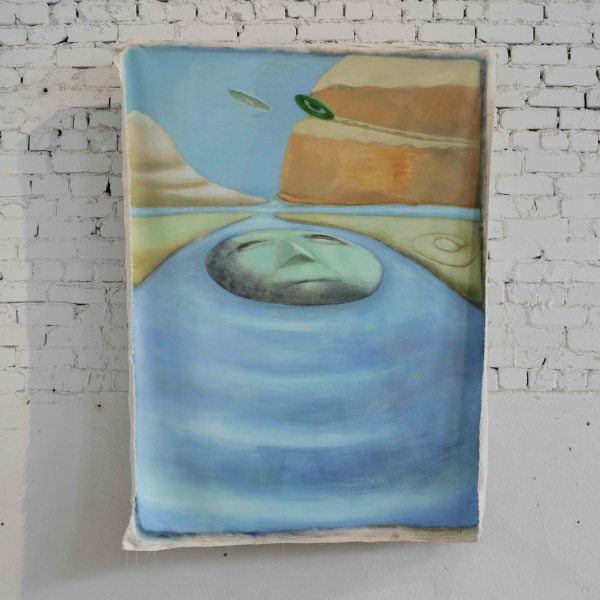
Bob Demper
This Machine
28.05 - 28.06.2025
Globālie finanšu tirgi ir plašas, sarežģītas sistēmas, kuras mazāk vada individuālie nodomi, bet vairāk algoritmu ātrums. Augstākajā līmenī milzīgas bagātības netiek radītas ar tradicionālu tirdzniecību, bet gan milisekundēs — automatizēti lēmumi, kurus izpilda serveri slepenos datu centros. Šajā arēnā kapitāls neguļ; tas paātrinās. Serveri ir varas infrastruktūra, ne mazāk kā naftas lauki vai dzelzceļi iepriekšējos gadsimtos.
Šie spēki veido fonu Boba Dempera mākslinieciskajai praksei. Kā vizuālais mākslinieks un filmu veidotājs Dempers veido vidi, kas pēta mūsdienu varas struktūras. Izstādei “This Machine” laikmetīgajā mākslas telpā TUR viņš ir izveidojis instalāciju, kas vienlaikus ir gan patstāvīgs mākslas darbs, gan filmēšanas laukums viņa ilgtermiņa pilnmetrāžas filmas projektam, kas uzsākts 2019.gadā.
Dempers veido vides, kas balansē starp pazīstamo un mākslīgo. Tās atgādina kino filmēšanas laukumus, pateicoties spējai uzvedināt uz stāstījumu un saglabāt noskaņu. Tās nav skatuves teatrālā izpratnē, bet gan skulpturālas ainas — rūpīgi izkārtotas, tonāli precīzas un vairāk rosinošas nekā uzspiestas. Tās neskaidro; tās izsauc izjūtas. Izstādē skatītājs ieaicināts telpā, kuras nozīme nav noteikta, bet plūstoša — vietā, kur var sākties kāds stāsts vai dzimt kāds jautājums. Darbs nemanāmi rosina domāt, ka globālā finanšu sistēma — ko pārvalda necaurspīdīgi algoritmi un automatizēti darījumi — ir kļuvusi tik sarežģīta, tik abstrakta, ka neviens cilvēks to pilnībā nesaprot. Un varbūt tieši tas arī ir būtiski: sistēmās bez pārraudzības, vara kļūst neredzama, un pati realitāte sāk kropļoties.
Dempera ilgtermiņa projekta centrā ir Donijs — izdedzis finanšu darbinieks, kurš klīst ainavā, ko veidojusi institucionālās loģikas atstātā ietekme. Filma nav veidota kā parasts, lineārs stāstījums. Tā veidojas fragmentos — ainās, kas uzņemtas iepriekšejo izstāžu laikā un to apkārtnē, iedvesmojoties no instalāciju materiālajām un telpiskajām īpašībām. Izstādē “This Machine” Dempers pirmo reizi ievieš jaunu tēlu: Donnu — Donija kolēģi, (nevis priekšnieci vai kaimiņieni) iezīmējot pavērsienu stāstījuma attīstībā.
“This Machine” centrā ir spriedze starp redzamo un apslēpto, starp mākslīgo un infrastruktūru. Kas mūsdienās vispār ir īsts, ja lēmumus, kas veido mūsu ekonomiku, sabiedrību un nākotni, pieņem nevis cilvēki, bet gan kods? Globālie finanšu tirgi — tik bieži abstrakti, algoritmiski un neaizsniedzami — darbojas ar teju sirreālu atrautību no ikdienas dzīves. Dempers ataino šo spriedzi, izpludinot robežas starp fikciju un realitāti un radot pasaules, kas šķiet gan tuvas un intīmas, gan vienlaikus svešas, atsvešinātas, ticamas un iluzoras.
Izstāde nesniedz atbildes vai skaidrojumus. Tā piedāvā sajūtu par tepu, kurā viss ir apturēts — vietu, kur sarežģītās sistēmas netiek atklātas vai izskaidrotas, bet gan izjustas. Tā aicina skatītājus būt kopā ar nenoteiktību, sajust to spēku aprises, kas parasti paliek apslēpti skatienam. Šajā procesā darbs atver klusāku uzmanības formu: tādu, kas apzinās, cik daudz mēs nezinām, un cik steidzami mums jāiemācās redzēt tumsā.
Kurators un teksts: Edvards Shautens
Projekta vadītāja: Kristīne Ercika
Producente: Ada Ruskeviča
Tehniskais atbalsts: Tils Zigmunds Ozoliņš, Maksimilians Kotovičs, Patrīcija Vilsone, Juliuss Tisens (Julius Thissen) un TUR komanda
Papildu skaņu dizains: Ernests Vilsons
Grafiskais dizains: Andris Kaļiņins
Lomās: Riks van Ūms (Rick van Uum)
Kinematogrāfija: Pedro Goslers (Pedro Gossler)
Grims: Robs Hilebrinks (Rob Hillebrink)
Audiovizuālais dizains: Tims Dempers (Tim Demper)
Izstādi atbalsta Valsts Kultūrkaptāla fonds un STROOM
This Machine
28.05 - 28.06.2025
The global financial markets are vast, complex systems governed less by individual intention than by algorithmic velocity. At the top, immense fortunes are generated not through traditional trade but through milliseconds – automated decisions executed by servers housed in secretive data centers. In this arena, capital doesn’t sleep; it accelerates. Servers are the infrastructure of power, not unlike oil fields or railroads in previous centuries.
These forces form the backdrop for Bob Demper’s artistic practice. As both a visual artist and filmmaker, Demper builds environments that explore contemporary structures of power. For This Machine, his exhibition at TUR, he has constructed an installation that operates as both a work in its own right and, when needed, as a set for his ongoing feature or longer film project, begun in 2019.
Demper constructs environments that hover between the familiar and the fabricated. They resemble movie sets in their capacity to suggest narrative and hold atmosphere. These are not stages in the theatrical sense, but sculptural scenes – carefully arranged, tonally specific, and suggestive rather than prescriptive. They do not explain; they evoke. In This Machine, the viewer is invited into a space where meaning is not fixed, but flickering – where a story might begin, or where a question might take root. The work quietly proposes that the global financial system – dominated by opaque algorithms and automated trades – has become so complex, so abstracted, that no single human fully understands its operation. And perhaps that’s the point: in systems without oversight, power becomes invisible, and reality itself begins to distort. At the core of Demper’s ongoing project is Donny, a burnt-out financial worker drifting through a landscape shaped by the aftermath of institutional logic. The film is not constructed in a conventional, linear fashion. Instead, it evolves through fragments – scenes filmed in and around each exhibition, shaped by the material and spatial qualities of the installations themselves. For This Machine, Demper introduces a new character for the first time: Donna – Donny’s coworker, not boss and neighbour – marking a shift in the unfolding narrative.
At the heart of This Machine is a tension between visibility and concealment, artifice and infrastructure. What is real anymore, when decisions that shape our economies, societies, and futures are made not by people, but by code? The global financial markets – so often abstracted, algorithmic, and unreachable – operate with a kind of surreal detachment from daily life. Demper mirrors this quality: blurring the boundaries between fiction and reality, constructing worlds that feel both intimate and estranged, credible and illusory.
This Machine doesn’t provide answers or explanations. It offers a space of suspension – where complex systems are not decoded, but felt. It invites viewers to sit with uncertainty, to sense the contours of forces that are normally hidden from view. In doing so, it opens up a quieter kind of attention: one that acknowledges how much we don’t know, and how urgently we need to learn to see in the dark.
Exhibition Curator and text: Edd Schouten
Project Manager: Kristīne Ercika
Production Manager: Ada Ruszkiewicz
Additional Sound Design: Ernests Vilsons
Technical Support: Tils Zigmunds Ozoliņš, Maksimilians Kotovičs, Patrīcija Vilsone, Julius Thissen and TUR Team
Graphic Design: Andris Kaļiņins
Cast: Rick van Uum
Cinematography: Pedro Gossler
Special Make-up: Rob Hillebrink
AV Show Design: Tim Demper
The exhibition is supported by VKKF and STROOM
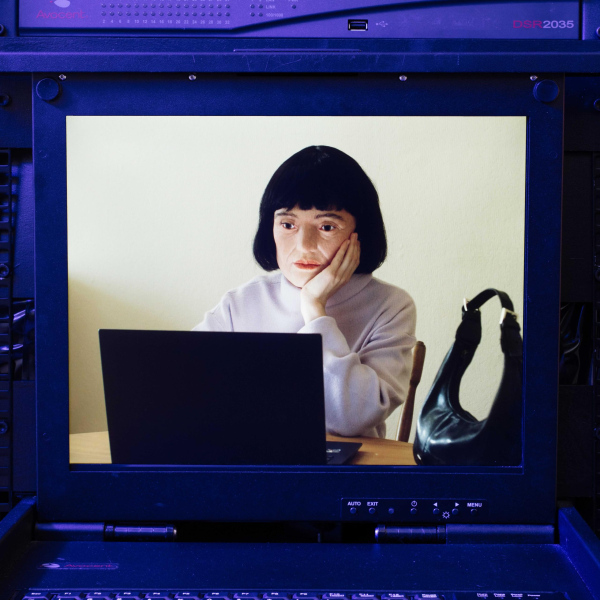
Voldemārs Johansons
Thawing (atkusnis)
02.04 - 03.05.2025
Mākslinieks un komponists Voldemārs Johansons savā jaunākajā veikumā “Thawing” (atkusnis) aplūko ērģeles – vienu no Rietumu mūzikas tradīcijā fundamentālākajiem instrumentiem – kā imersīvu skulptūru. Izmantojot tērauda, skaņas un telpiskās kompozīcijas sintēzi, Johansons konstruē iekļaujošu akustisko vidi, kurā apmeklētāji tiek aicināti pārvietoties skaņas laukā, mainoties perceptuālajai mākslas darba uztverei.
“Thawing” ir skulpturāls instruments, kas ļauj piedzīvot skaņas fizikalitāti. Tērauda caurulēm veidotais darbs ir iedvesmots no ērģeļu stabulēm un darbojas, membrānai ierosinot kustību, kas rada rezonansi gaisa stabā. Skulptūra iemieso stāvviļņu (standing wave) fenomenu – skaņas viļņu svārstības telpā nosaka skaņas toņu augstumu un harmonisko struktūru. Atšķirībā no tradicionālajām ērģelēm, Johansona skulpturālās kompozīcijas kvadrātstabules ir izkārtotas izstādes telpā un izkliedē skaņu, ļaujot piedzīvot dinamisku un līdzdalīgu klausīšanās pieredzi.
Kustības un uztveres mijiedarbe ir “Thawing” pamatā. Apmeklētāji, pārvietojoties izstāžu telpā, piedzīvo mainīgus, skaņas radītus iespaidus gan reālās, gan iedomātas skaņas dimensijās. Pati kompozīcija ir algoritmiski vadīta un attīstās, izmantojot elektronisku sistēmu, kas modulē gaisa plūsmu un skaņas sekvences. Tādējādi rodas mainīga skaņas ainava, kas akcentē formas, vibrācijas un cilvēka klātbūtnes saikni.
Papildus tērauda caurulēm un skaņai darbu veido tikpat būtiska, taču nemanāma komponente. Šī neredzamā algoritmu, shēmu un kodu sistēma ir apzināti noslēpta, lai priekšplānā izceltu skulptūras radīto sensoro pieredzi. Līdzās tērauda konstrukcijām Johansons veido skulptūras neredzamās, bet sarežģītās sistēmas, panākot to uztveri ar programmētu skaņas struktūru palīdzību. Lai gan darba būtība galvenokārt slēpjas radītajā audiālajā pieredzē, sarežģītais elektroniskais pamats joprojām ir neatņemama mākslinieciskās nozīmes daļa.
Johansona radošā prakse ir dziļi sakņota mākslas, zinātnes un tehnoloģiju krustpunktā. Šī metodoloģija iepriekš saskatāma tādos darbos kā “Aero Torrents” un “Concord”, kur dabas spēki un skaņas parādības saplūst imersīvās instalācijās. Izglītību ieguvis Hāgas Karaliskās konservatorijas Sonoloģijas institūtā (Institute of Sonology at the Royal Conservatory of The Hague), Nīderlandē un Latvijas Mūzikas akadēmijā; konsekventi paplašinājis skaņu mākslas robežas, piedaloties tādos prestižos notikumos kā Venēcijas arhitektūras biennāle, Ars Electronica un Ruhrtriennale. Viņa pētījumi Jāzepa Vītola Latvijas Mūzikas akadēmijā un mākslinieciskā vadītāja darbs festivālā SWRL apliecina mākslinieka meklējumus, paplašinot diskursu par skaņu, telpu un uztveri.
Šī skulptūra ir meditācija par skaņas fiziskajām un akustiskajām īpašībām. Tā aicina klausītājus pieredzēt to, kā skaņa veido telpu un, savukārt, kā telpa nosaka klausīšanās pieredzi. Tādējādi Johansons gan godina, gan pārrada ērģeles, paplašinot to nozīmi ar mūsdienu māksliniecisko un zinātnisko pētījumu palīdzību.
Kurators un teksts: Edvards Shautens
Teksta tulkojums: Andris Freibergs
Projekta vadītāja: Kristīne Ercika
Producenti: Ada Ruskeviča un Andris Freibergs
Grafiskais dizains: Andris Kaļiņins
Thawing
02.04 - 03.05.2025
For Thawing, Latvian sound artist and composer Voldemārs Johansons reimagines the organ – one of the most venerated instruments in Western musical tradition – as an immersive sculptural and sonic experience. Through a synthesis of steel, sound, and spatial composition, Johansons constructs an interactive acoustic environment where the audience is invited to move within the sound field, shaping their own perceptual engagement with the work.
At its core, Thawing is a sculptural instrument that transforms the physicality of sound into a tangible form. Constructed from steel pipes modeled after organ pipes, the installation operates on the principle of air flowing through a diaphragm – a membrane that initiates movement – to generate low, resonant tones. The installation reflects on the phenomenon of standing waves – the oscillatory behavior of sound waves confined within a structure – which determine the pitch and harmonic composition of the tones emitted. Unlike a traditional organ, where the pipes are arranged for projection, Johansons' sculptural configuration disperses sound throughout the space, allowing for dynamic and participatory listening experiences.
The interplay between movement and perception is fundamental to Thawing. As visitors navigate through the installation, they experience shifting auditory perspectives, engaging with both the real and imagined dimensions of sound. The composition itself is algorithmically driven, unfolding in real-time through an electronic system that modulates the air flow and sonic sequences. The result is a living, evolving soundscape that underscores the interconnectivity of form, vibration, and human presence.
Beyond the interplay of steel pipes and sound, an equally vital yet hidden component shapes the work: a "sculpture in logic." Deliberately concealed to foreground the sensory experience, this unseen architecture of algorithms, circuits, and code mirrors the sculptural physicality, structuring the audience's experience just as tangibly. In addition to assembling steel into a sculptural installation, Johansons sculpts with invisible yet intricate systems, shaping perception through programmed structures. While the essence of the work lies in the experience of sound above all, the complex electronic foundation remains an integral part of its artistic significance.
Johansons' practice is deeply rooted in the intersection of art, science, and technology, a methodology evident in works such as Aero Torrents and Concord, where natural forces and sonic phenomena converge in immersive installations. Educated at the Institute of Sonology at the Royal Conservatory of The Hague, The Netherlands, and the Latvian Academy of Music, he has consistently pushed the boundaries of sound-based art, exhibiting at prestigious venues such as the Venice Architecture Biennale, Ars Electronica, and the Ruhrtriennale. His research at the Jāzeps Vītols Latvian Academy of Music and his curatorial work at the SWRL festival further reinforce his commitment to expanding the discourse on sound, space, and perception.
Thawing is a meditation on the physical and ephemeral qualities of sound. It invites the audience into an experiential dialogue where structure and sonority intertwine, emphasizing the way in which sound shapes space and, in turn, how space conditions the listening experience. In doing so, Johansons both honors and reinvents the organ, expanding its legacy through contemporary artistic and scientific inquiry.
Text and curated by: Edd Schouten
Project Manager: Kristīne Ercika
Production Support: Ada Ruszkiewicz and Andris Freibergs
Graphic Design: Andris Kaļiņins
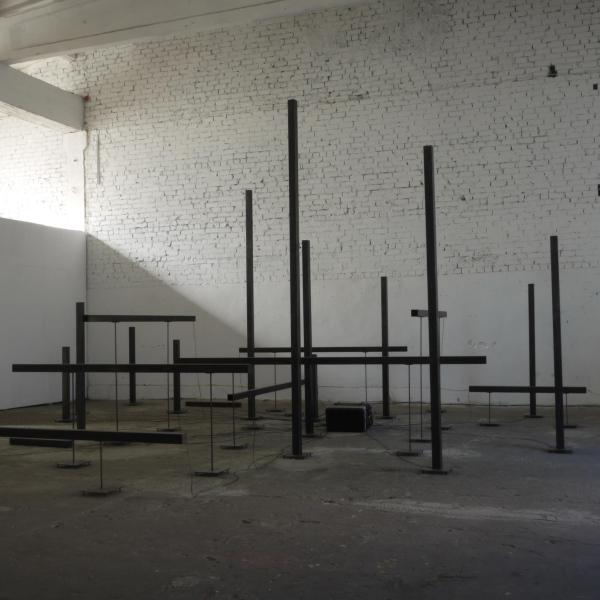
Kristīne Daukšte
Migla velk mīkstāku malu
19.02 - 22.03.2025
Kristīnes Daukštes darbs ieved skatītāju telpā, kas šķietami atrodas fiskētā pārmaiņu mirklī – kaut kur starp sataustāmo un teju izzūdošo, dabisko un mākslīgi konstruēto. Instalācija veidota, apzināti sadarbojoties ar TUR telpu, kurai raksturīgās īpatnības kļuvušas par katalizatoru ideju, materiālu un formu saplūsmei. Reaģējot uz tai piemītošo atmosfēru un iepriekšējo notikumu atstātajiem nospiedumiem, darbs kļūst par apkārtējās vides paplašinājumu, kas veidots trauslā dialogā ar iekšpusē notiekošo. Viņas instalācija simboliski izaug no pašas telpas būtības, iedzenot saknes netverama pirmatnīgā pamata klātesamībā. Līdzīgi kā pēc kāda nenoteikta laika nastas migla būtu pacēlusies un atklājusi skatam ainavu, kas no tās izaugusi, tiek atsegti materiāli un to saiknes ar aplūkotajiem konceptiem un Daukštes māksliniecisko praksi.
Instalācija neuzspiež sevi telpai, bet gan ļaujas tajā organiski iemiesoties un to respektē – TUR ar savu plašo atvērtību, pakļaušanos dabas stihijām, veidu, kā daba tajā ieplūst caur teju nemanāmām spraugām. Mitrums, aukstums, mainīgais apgaismojums – tie ne tikai ieskauj mākslas darbu, bet arī to veido, kļūstot par formas un nozīmes neatņemamu sastāvdaļu. Gluži tāpat kā migla, darbs pretojas stingrai definīcijai; tas ir svārstīgs, tādēļ rosina uz daudzslāņainu interpretāciju. Filozofu Žila Delēza (Gilles Deleuze) un Fēliksa Gvatari (Félix Guattari) formulētais “rizoma” (rhizome) jēdziens – savstarpēji saistītā sistēma bez hierarhijas – piedāvā vērtīgu skata punktu instalācijas uzlūkošanai: tā ir kā domu ainava, kas atsakās no atsevišķiem, noteiktiem naratīviem. Tā vietā, lai būtu statisks objekts, instalācija metaforiski kļūst par notikumu, kas mainās līdzās skatītāja kustībai. Navigācija telpā – pārvietošanās, apstāšanās, palūkošanās uz leju, gluži kā dodoties pastaigā pa meža taku, – kļūst par daļu no pieredzes, iemiesotu izvēlētajā virzienā.
Instalācija, kas sastāv no abstraktiem izgriezumiem – šķietamu ziedlapu vai pat vēl lielāku veselumu fragmentiem –, stiepjas horizontāli, atbalsojot dabisko veidojumu nojausmu un vienlaikus mudinot domāt par cilvēka iejaukšanos. Tā svārstās starp dažādiem interpretatīviem stāvokļiem: kā būve, kas varētu tikt tulkota kā pajumte, siltumnīca vai kāda izrakumu paliekas. Tās klātesamība ir gan stabila, gan īslaicīga, atspoguļojot nedrošu līdzsvaru arī starp materiālo noturību un neizbēgamo sadalīšanos laikā. Tāpat kā kartogrāfiskais plūsmas vingrinājums, tā neiezīmē telpu kā fiksētu vienību, bet gan kā attiecību tīklu – plūstošu un pastāvīgi mainīgu.
Kurators: Edvards Shautens
Gaismas dizains: Maksimilians Kotovičs
Projekta vadītāja: Kristīne Ercika
Producēšanas atbalsts: Ada Ruskeviča un Andris Freibergs
Grafiskais dizains: Andris Kaļiņins
Izstādi atbalstīja: Valsts Kultūrkapitāla fonds
The Fog Draws a Softer Edge
19.02 - 22.03.2025
Kristīne Daukšte’s new work invites visitors into a space that feels like it’s caught in a moment of change – somewhere between the solid and the fleeting, the natural and the constructed. Her installation emerges from a deep engagement with the space of TUR, where its distinct characteristics have acted as a catalyst for ideas, material, and form to converge. In response to its atmosphere and the layered traces of what came before, the work takes shape as an extension of its surroundings, subtly guided by the creative dialogue that unfolds within it. Her installation feels suspended from a ground layered by previous presence and appears to be growing naturally from the essence of the space. As if, after some indistinct weight of time, a fog has lifted and revealed a landscape that has grown organically from it, exploring material and how it relates to her concepts and artistic practice.
The installation does not impose itself on the space but rather unfolds within and acknowledges it – TUR, with its vast openness, its exposure to the elements, the way nature encroaches through gaps and seams. The humidity, the cold, the shifting light – they do not merely surround the work but shape it, becoming integral to its form and meaning. Like fog itself, the work resists rigid definition; it hovers, it shifts, it invites multiple readings. Philosophers Deleuze and Guattari’s concept of the rhizome – an interconnected system without hierarchy – offers a useful lens through which to read this work: a landscape of thought that refuses singular narratives. Rather than being a static object, the installation becomes an unfolding event, an encounter that shifts with the movement of the viewer. The act of navigating the space – walking, pausing, looking downward as one might on a forest path – becomes part of the experience, an embodied form of wayfinding.
Composed of abstract cutouts – leaf-like, petal-like, perhaps fragments of a larger whole – the installation extends horizontally, echoing natural formations while also suggesting traces of human intervention. It oscillates between states: a structure that could be a shelter, a greenhouse, a remnant of excavation. Its presence is both grounded and ephemeral, evoking the precarious balance between material permanence and inevitable dissolution. Like a cartographic exercise in flux, it does not map space as a fixed entity but as a network of relations – fluid, contingent, and ever-changing.
Curator: Edd Schouten
Light Design: Maksimilians Kotovičs
Project Manager: Kristīne Ercika
Production Support: Ada Ruszkiewicz and Andris Freibergs
Graphic Design: Andris Kaļiņins
Supported by the Latvian State Culture Capital Foundation
Photography Kristīne Madjare

Liene Pavlovska
Gruzdošie zibšņi
08.01 - 08.02.2025
Izstādē “Gruzdošie zibšņi” Liene Pavlovska veido telpu aptverošu instalāciju, kas savij kopā personīgo un kolektīvo, pievēršoties padomju laika sadzīves ēnas pušu atbalsīm, valsts kontroles un to pārdzīvotāju sadrumstalotajām vēsturēm. Pavlovskas veikums pamatā iztaujā atmiņas, ko raksturo fiziska vardarbība un apreibinošo vielu lietošana – atmiņas, ko viņa varēja atstāt noklusētas, bet tā vietā tās tiek izceltas priekšplānā. Vintāžas tapešu un veco fotoalbumu papīra izmantošana līdzās abstraktiem akvareļiem veido naratīvu, kas izjauc robežas starp individuālo un politisko. To darot, viņa kritizē kontroles sistēmas, vienlaikus piedāvājot gan fiziskās, gan emocionālās telpas atgūšanu atmiņai un brīvības improvizācijai. Pavlovskas instalācija ir gan personiska konfrontācija ar nemierīgo pagātni, gan cieņa pret izturību, piedāvājot telpu pārdomām, kas pārveido destruktīvos pagātnes ciklus un virzās uz priekšu.
Viņas instalācijā sapņaini elementi kļūst par atmiņu dekoru, ielūdzot skatītājus gaistošu pagātnes nospiedumu pasaulē, kurā abstrakti akvareļi it kā peld iekšup un ārpus mirklīga tvēruma gluži kā nemierīgas audzināšanas zibšņi. Šī fragmentārā atmiņu ainava, kas pasniegta raupjā, teatrālā estētikā, rada vidi, kas vienlaikus ir gan personiska, gan universāla. Estētiskās nepilnības ir apzinātas: Pavlovska aptver nelīdzenumus, šīs “kļūdas”, ļaujot tām kļūt par stāstījuma daļu, nevis mēģinot noslēpt. Tādā veidā viņa izaicina ideju par perfekciju un rada iespēju izkļūt neapzinātajām nozīmēm no tā, kas ticis iepriekš noklusēts.
Lai gan darbs atzīst traumas smagumu, iespējama ir arī izeja — ceļš uz dziedināšanu. Taču ceļojums nav viegls. Mākslinieces cīņa ar pašārstēšanos un alkohola lietošanu izstādē parādās kā aicinājums atpazīt un atzīt dziedināšanas procesu. Noraidot spiedienu pielāgoties idealizētai “pareizības” versijai, Pavlovska ļauj saviem materiāliem salūzt, sabrukt, saplīst, deformēties, tādējādi paverot telpu jaunām iespējām un alternatīviem naratīviem. Māksliniece pievēršas sadzīves cīņu ēnām — alkoholam un fiziskai vardarbībai, valsts kontroles sekām —, tomēr tā nemēģina apsūdzēt, bet gan radīt telpu pārdomām, ļaujot skatītājiem stāties pretī neizrunātajām patiesībām, kas veido gan personīgo, gan kolektīvo identitāti.
Balstoties uz tādiem teorētiskiem ietvariem kā Gija Debora (Guy Debord) kritika par izrādes sabiedrību un Hannas Ārentes (Hannah Arendt) pētījumi par publisko un privāto dzīves organizāciju, Pavlovska konstruē skatuvi, uz kuras personīgā pieredze ir pretstatīta vēsturisko spēku fonam. “Gruzdošie zibšņi” veido saikni starp individuālo un universālo. Starp kvēlojošām oglēm un spilgtām gaistošām personīgās un kolektīvās atmiņas dzirkstelēm Pavlovska aicina apmeklētājus iesaistīties kopīgā dziedināšanā caur kolektīvās vēstures atpazīšanu, atzīšanu un dialoga veidošanu.
Kurators: Edvards Shautens
Gaismas dizains: Maksimilians Kotovičs
Projekta vadītāja: Kristīne Ercika
Producēšanas atbalsts: Ada Ruskeviča un Andris Freibergs
Tehniskais atbalsts: Oskars Pavlovskis
Grafiskais dizains: Andris Kaļiņins
Izstādi atbalstīja: Valsts Kultūrkapitāla fonds
The Smoldering Flashes
08.01 - 08.02.2025
In "The Smoldering Flashes" Liene Pavlovska creates a space encompassing installation that weaves together the private and the collective, drawing from the remnants of Soviet-era domestic life, state control, and the fragmented histories of those who lived through them. At its core, Pavlovska’s work addresses the trauma of memory, marked by physical and substance abuse — memories she could have left obscured, but instead bring to the surface. Her use of vintage wallpaper and old photo album paper, along with abstract watercolor paintings, forms a narrative that blurs the boundaries between the personal and the political. By doing so, she critiques systems of control while offering a reclaiming of space — both physical and emotional — for memory and improvisation. Pavlovska’s immersive installation is both a personal confrontation with a troubled past and an homage to resilience, offering a space for reflection that transforms destructive cycles and moves forward.
In her installation, dreamlike elements become a decor of memory, where Pavlovska invites viewers into a world of fleeting recollections where abstract watercolors seem to float in and out of grasp, like flashes of a troubled upbringing. This fragmented memory landscape, presented in a rough, theatrical aesthetic, evokes an environment that is at once personal and universal. The aesthetic imperfections are intentional: Pavlovska embraces the irregularities, the "mistakes," allowing them to become part of the narrative rather than conceal them. In doing so, she challenges the idea of perfection and invites unexpected meanings to emerge from what was hidden.
Though the work acknowledges the weight of trauma, there is also a way out — a path toward healing. But the journey is not an easy one. The artist’s own battle with self-medication and alcohol abuse is present in the work as an invitation to engage in the complexity of personal struggle. By rejecting the pressure to conform to an idealized version of “correctness,” Pavlovska allows her materials to break, to fall apart, to rip, to curl and thereby opens a space for new possibilities and alternative narratives to emerge. Pavlovska addresses the shadows of domestic struggles — alcohol and physical abuse, the effects of state control — yet it does not seek to accuse but rather to provide a space for reflection, allowing viewers to confront the unspoken truths that shape both personal and collective identities.
Drawing on theoretical frameworks like Guy Debord’s critique of the spectacle and Hannah Arendt’s distinction between the public and private realms, Pavlovska creates a stage where personal experiences are played out against the backdrop of historical forces. "The Smoldering Flashes" weaves connections between the personal and the universal. In the glowing embers and fleeting sparks of both individual and collective memories, Pavlovska extends an invitation: to engage in collective healing through recognition, dialogue, and the acknowledgment of shared histories.
Curator: Edd Schouten
Light Design: Maksimilians Kotovičs
Project Manager: Kristīne Ercika
Production Support: Ada Ruszkiewicz and Andris Freibergs
Technical Support: Oskars Pavlovskis
Graphic Design: Andris Kaļiņins
Supported by the Latvian State Culture Capital Foundation
Photography Kristīne Madjare

Liminal Limbo
Liminal Limbo, Group exhibition
25.10 - 30.11.2024
Liminal Limbo brought together new work from four artists – Katrina EW, Oto Holgers Ozoliņš, Kristina Rezviha, and Patrīcija Māra Vilsone – who are on the cusp of Generation Z and Millennials. The premise of the exhibition was for these artists to create personal reflections on the times we live in, specifically from the perspective of a generation that has just begun to arrive on the scene and participate in cultural conversations with voices that carry significant and insightful reflections on humanity and the future course of history. As with every generation, Gen Z is shaped by the events and technological shifts that have occurred during their formative years. Gen Z is often characterized by their adaptability, social consciousness, and digital fluency, though they also face challenges such as heightened anxiety and a tendency towards instant gratification.
A fifth contribution to Liminal Limbo is the new structure, a meeting place within TUR. Reinijs Acht, Nikita Merkushin, and Kate Onckule – who, like the artists, navigate the liminal space between Generation Z and Millennials were tasked with creating a liveable environment within TUR’s expansive space. Their project mirrors the broader challenges faced by Gen Z reflecting the precarious future their generation inherits, where resources grow scarce and funding for creative ventures continue to dwindle. By repurposing materials from TUR’s previously dismantled cube, the design not only transforms the space physically but also serves as a metaphor for the adaptive resilience required of their generation – crafting something meaningful out of the remnants of what came before, even in uncertain times.
Katrina EW's installation is deeply rooted in themes of self-healing, generational change, and the evolving nature of love and identity. Her work carries an undercurrent of social critique, particularly through the juxtaposition of her “lucky/guilty” concept. While her generation may enjoy more freedom, it remains burdened by the legacy of past traumas. Katrina EW explores the tension between generational trauma and healing, emphasizing the younger generation’s embrace of self-care and creative expression as a means to overcome inherited limitations, in contrast to the emotional repression of previous generations. Princess Diana, both a tragic figure and a symbol of freedom and rebellion, is reimagined as a symbol of female empowerment. In this vision, she evolves in a “healing womb” and becomes a “lesbian dream” — a metaphor for reclaiming feminine identity and rejecting traditional expectations.
In her new work for Liminal Limbo, Patrīcija Māra Vilsone explores the complex emotional turmoil of living in the freedom her parents and grandparents struggled and sacrificed for. Her sculptural installation is rooted in a sense of nostalgic longing. She compares her experience to the trains of the past, present, and future, the past represents the trains that deported her grandparents east, a painful legacy of sacrifice, while the future promises opportunities further west with projects like Rail Baltica. Yet, despite this hope, Vilsone feels suspended in a liminal space — stuck on a station platform of the present, grappling with the weight of leaving behind her family, and the foundation they created here, for a better future. The inefficiency of the trains mirrors the tangled emotional web that keeps her rooted in place, torn between the sacrifices of the past and the potential of what lies ahead.
Kristina Rezviha creates a "concrete garden" to reflect the disillusionment and challenges faced by Generation Z. Symbolic plants are placed in a concrete floor — representing the brutal reality of systemic barriers such as financial instability, ecological devastation, and a hyper-competitive job market — where growth seems impossible. These plants, though rooted in symbolic expectation, will never bloom, highlighting the gap between aspiration and reality. Through this installation, Rezviha contrasts the nostalgic values of previous generations, who had stronger connections to nature and greater access to stable careers, education, and home ownership, with the current generation’s struggle to attain these once-attainable goals. The emotional resonance of her work underscores the paradox of hope amidst unattainable dreams.
Oto Holgers Ozoliņš’s work for Liminal Limbo reflects his deep concern over the increasing militarization of recent years, a reality his generation may have to face more directly in the near future. Ozoliņš critiques the way the powerful treat war as a game, with younger generations bearing the cost. He draws inspiration from an era when toys shamelessly glorified war and militarization, acting as tools of indoctrination for future soldiers. Using repurposed materials — reflecting the scarcity of resources his generation must also contend with — he sculpts new interpretations of “toys for boys.” These modern-day tin soldiers now bear the injuries, PTSD, and other scars that war inflicts, the true consequences of conflict. In his reinterpretation of the traditional mobile, warplanes engaged in dogfights are replaced by drones, symbolizing today's battlefield innovations.
Curator: Edd Schouten
Project manager: Kristīne Ercika
Production support: Ada Ruszkiewicz, Andris Freibergs
Light Design and Technical Support: Maksimilians Kotovičs
Graphic design: Andris Kaļiņins
Special thanks: Olafs Balčūns, Rudolf Bekic, Jonas Büchel, Rudolfs Dainis Šmits, Kristers Šumila, Māris Timma.
Supported by: State Culture Capital Foundation of Latvia, RISEBA FAD, Rilak Paints, Tallinas ielas kvartāls, Angārs.
Photography Kristīne Madjare
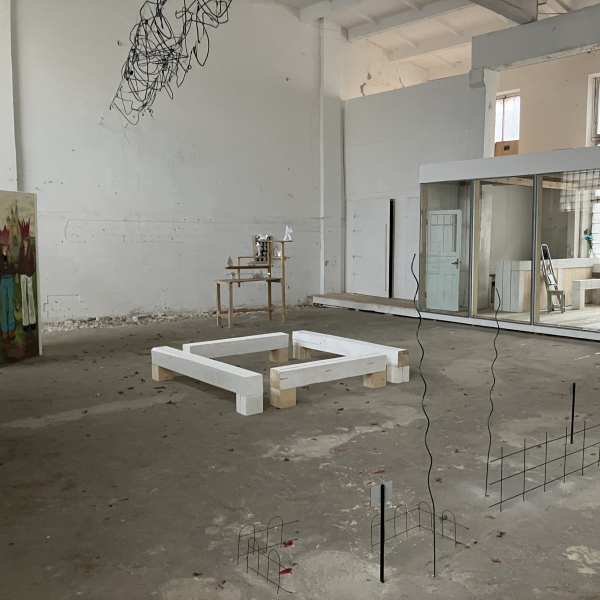
Reinis Dzudzilo
ONE WILL HEART ONE
21.08 - 21.09.2024
TUR telpas kurators Edvards Shautens Vienu dienu pirms atklāšanas reflektē Reiņa Dzudzilo izstādi.
A.
Ak.
O.
Viens.
Tam kaut kur ir jāsākas
Un "A"
Vai “Viens”
Ir tikpat labs sākums, kā jebkurš.
Viens.
Sirdīs.
Vienu.
Telpa starp
Sirdi un Sāpēt
Ir fonētiski maza,
Tomēr bezgalīgi plaša.
Lietu sfērā
Divi Vieni varētu būt
Vienpadsmit
Un Viens un Viens
Vienkārši būt spēle
Spēlēja
Uz divām pusēm
Uz nenoteiktu laiku
Līdz tas beidzās.
Reinis Dzudzilo vienu mēnesi pirms izstādes atklāšanas raksta kuratoram Edam Shautenam:
Gluži kā vārda “One” pirmais burts, arī lode ir apaļa. Zemeslode vai bumba, kuru iesist atvērtā telpā, kurā pati telpa tur kļūst par vārtiem.
Ekspozīcijas nosaukums tā arī palika neiztulkots, bet, lūk, šeit to atveru latviešu valodā. Viens sirdīs vienu. Vārds “sirdīs” jālasa kā darbības vārds starp abiem vieniem, nevis kā lietvārda daudzskaitlis. Lai gan var lasīt, kā vien grib, un jo atvērtāk, jo labāk. Angļu valodas “hurt” un “heart” vismaz manās ausīs atrodas tuvu. Latviešu valodas tulkojumā, meklējot tiem vienu un to pašu sākuma burtu, fonētiski tie nostāsies tālāk viens no otra. Sāpināt un Sirds.
Vieglā un spēlei atsaucīgā bumba ekspozīcijā ieņem tādu daiļumu, kurš jākaļ akmenī, kā Umberto Eko rakstīja “Skaistuma vēsturē”. Savukārt bumba jāraida tieši debesīs, kuras ir lielākie vārti.
Kurators: Edvards Shautens (Edd Schouten)
Projekta vadītāja: Kristīne Ercika
Producēšanas asistents: Andris Freibergs
Gaismas un tehniskais atbalsts: Maksimilians Kotovičs, Ivars Ozols
Grafiskais dizains: Andris Kaļiņins
Mediatori: Beatrise Grudule un Eva Sopiak (Eva Shopjak)
Atbalsta: Valsts kultūrkapitāla fonds, Latvijas Nacionālais teātris, STROOM Hāga, Radio NABA un RILAK (Rīgas Laku un krāsu rūpnīca)
ONE WILL HEART ONE
Curator Edd Shouten reflects on Reinis Dzudzilo's exhibition One day before the Opening.
A.
Ah.
O.
One.
It has to begin somewhere—
And “A”
Or “One”
Is as good a place as any.
One.
Will.
Heart.
One.
The space in between
Heart and Hurt
Is phonetically small,
Yet infinitely vast.
In the sphere of things,
Two ones could be
Eleven.
And one and one could
Simply be a game
Played
On two halves
Indefinitely,
Until it ends.
Artist Reinis Dzudzilo writes to curator Edd Shouten one month before the exhibition:
Just like the first letter of the word "One," the ball is round — a globe or sphere kicked into an open space, where the space itself becomes a gateway.
The title of the exhibition remains solely in English, untranslated into Latvian: ONE WILL HEART ONE. HEART should be understood as a verb between the ONEs, rather than as a noun. But One is free to interpret it however they wish—the more open, the better. To my ears, in English, heart and hurt sound alike, a nuance lost in Latvian, where sirds (heart) and sāpināt (to hurt) are phonetically distant from each other.
The ball, light and responsive to the game, in the exhibition embodies a kind of beauty that, as Umberto Eco described in The History of Beauty, must be set in stone. Yet the ball must also be directed towards the sky, which is the ultimate goal.
Curator: Edd Schouten
Project manager: Kristīne Ercika
Production support: Andris Freibergs
Light Design and Technical Support: Maksimilians Kotovičs, Ivars Ozols
Graphic design: Andris Kaļiņins
Mediators: Beatrise Grudule and Eva Shopjak
Supported by: State Culture Capital Foundation of Latvia, Latvian National Theatre, STROOM The Hague, Radio NABA and Rilak Paints.
Photography Kristīne Madjare
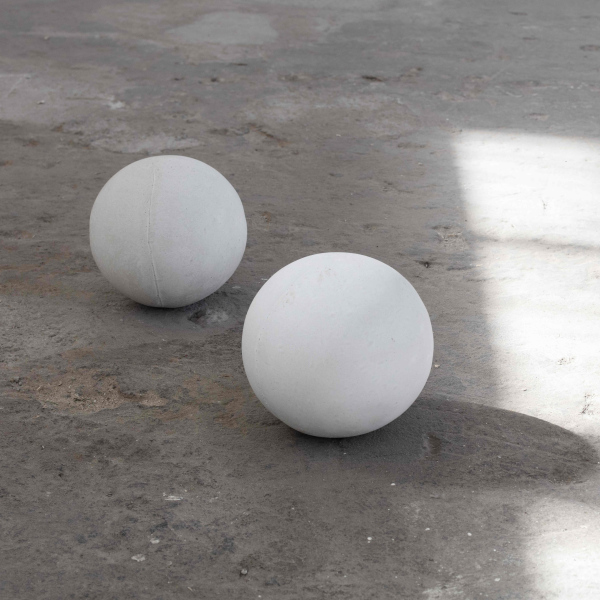
Ieva Saulīte
Neatlaidīgu domu saišķi
10.07 - 10.08.2024
Ievas Saulītes personālizstāde “Neatlaidīgu domu saišķi” ir otrā izstāde TUR_telpas 2024. gada vasaras ciklā “Pieķeršanās struktūru nojaukšana”. Saulīte pēta, kā personiskā pieredze, kultūras mantojums, populārā kultūra un apkārtējās vides ietekme saplūst vienkopus, veidojot mūsu pasaules uztveri. Caur mākslas darbiem viņa rosina skatītājus pārdomāt šīs daudzšķautņainās ietekmes un to atstātās pēdas uz mūsu kolektīvo apziņu.
Izmantojot glezniecību un tēlniecību kā medijus un darbos iekļaujot TUR_telpā atrastos materiālus, Saulīte iedziļinās neapzinātās iedvesmas netveramajā vieglumā. Darbos izmantotie motīvi un ritmi izriet no sirreālistu ieviestās automātiskā zīmējuma metodes, kad mākslinieka roka veido brīvus, abstraktus tēlus, tādējādi tiecoties atklāt zemapziņā mītošās domas un emocijas. Šīs gadiem ilgās mākslinieciskās prakses rezultātā Saulīte radījusi neskaitāmus zīmējumus un skices. No tiem māksliniece intuitīvi atlasījusi motīvus, kas iedzīvināti lielformāta gleznās un TUR_telpas videi veidotā instalācijā. Izstāde “Neatlaidīgu domu saišķi” aicina skatītājus ielūkoties alternatīvās realitātēs caur Saulītes perspektīvu, pārvarot plaisu starp noslēpumaino zemapziņu un sapņu pasauli un rosinot pārdomāt arī pašiem savu pieredzi.
Kurators: Edvards Shautens
Projekta vadītāja: Kristīne Ercika
Producēšanas asistenti: Andris Freibergs, Beatrise Grudule un Eva Sopiak (Eva Shopjak)
Gaismas un tehniskais atbalsts: Maksimilians Kotovičs un Rūdolfs Štamers
Grafiskais dizains: Andris Kaļiņins
Atbalsta: Valsts kultūrkapitāla fonds, STROOM Hāga, Radio NABA un RILAK
Bundles of Persistent Thoughts
Ieva Saulīte's exhibition, “Bundles of Persistent Thoughts”, is the second installment in TUR's 2024 summer cycle, “Breaking Down Structures of Affection”. Saulīte explores how personal experiences, cultural heritage, popular culture, and environmental influences converge to shape our perception of the world. Through her artworks, she prompts viewers to contemplate these multifaceted influences and their impact on our collective consciousness.
Using painting and sculpture, incorporating material remnants found in and around TUR's space, Saulīte delves into the elusive lightness of unconscious inspiration. Her initial method mirrors Surrealist automatic drawing, where the artist's hand moves freely to reveal subconscious thoughts and emotions through abstract forms. This years-long artistic practice has produced thousands of drawings and sketches. From these, Saulīte intuitively selected works that evolved into large-format paintings and three-dimensional sculptures resembling artifacts from parallel worlds.
“Bundles of Persistent Thoughts” invites viewers to peer into alternate realities through Saulīte's lens, bridging the gap between her mysterious subconscious and dreamlike world, and prompting reflection on their own experiences.
Curator: Edd Schouten
Project manager: Kristīne Ercika
Production support: Andris Freibergs, Beatrise Grudule and Eva Shopjak
Technical Support: Maksimilians Kotovičs and Rūdolfs Štamers
Graphic design: Andris Kaļiņins
Supported by: State Culture Capital Foundation of Latvia, STROOM, Radio NABA and Rilak Paints.
Photography Kristīne Madjare
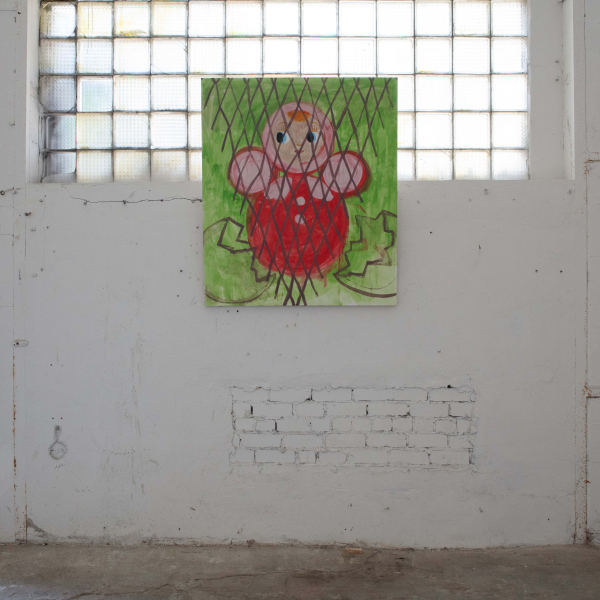
Bas de Boer
Shelter
29.05 - 29.06.2024
Aizrautība ar mērogu maketiem kalpo par de Būra izstādes sākumpunktu. Tie rada objektīvu priekšstatu par to, kā iecerētais projekts izskatīsies pēc tā realizācijas. Šie maketi iemieso visu to iespējamo potenciālu, kā arī optimistiskos solījumus to turpmākai izmantošanai. Tie simbolizē utopiju. Tomēr izstādē “Patvērums” de Būrs izzina mēroga modeļu distopiskās perspektīvas, ieskaujot gan globāla, gan personīga rakstura problēmas. Subjektīvā līmenī – gan pats, gan viņa draugi dzīvo nedrošā situācijā, kas skar viņu dzimto Nīderlandi, kur jau gadu desmitiem ir vērojama mājokļu krīze. Augstās īres maksas un dzīvesvietu drošības relatīvisms kļūst par realitātes slogu aizvien lielākam skaitam cilvēku. Nedrošā situācija pasaulē, globālā sasilšana un karš tuvu mūsu robežām apliecina, ka droša dzīvesvieta ir kļuvusi par visu ko citu, tikai ne garantiju.
Izstādes centrālajai ekspozīcijai mākslinieks ir radījis lielu rotējošu maketu, kas mudina domāt, ka tā varētu būt māja, mājoklis, rezidence. Taču ir skaidrs, ka šai struktūrai trūkst komforta un drošības. To “pasargā” lielāka izmēra modelis, kas ataino siltumnīcu – vietu, kur pasargāties no dabas stihijām un pabarot to, kas tajā atrodas. Taču siltumnīca ir apgāzta otrādi. Izgatavota no trausliem materiāliem, tā nepiedāvā itin nekādu reālu aizsardzību. Visa šī struktūra atkārto nenoteikto stāvokli, kurā atrodas pieaugošā cilvēku grupa – stāvokli, kurā drošība, aizsardzība un komforts ieskauti drūmā realitātes ainā. Pārējie dažādu izmēru mēroga modeļi, ko de Būrs izvietojis TUR_telpā, iemieso pārdomas par realitāti, kas kļūst arvien distopiskākas un kurās frāze – “Viss taču ir kārtībā!” – mijas ar ieslodzījuma sajūtu, no kuras izbēgt nav iespējams.
Kurators: Edvards Shautens
Producentes: Kristīne Ercika un Viktorija Vēbere
Producēšanas asistents: Andris Freibergs
Gaismas un tehniskais atbalsts: Maksimilians Kotovičs
Grafiskais dizains: Andris Kaļiņins
Atbalsta: Valsts kultūrkapitāla fonds, STROOM Hāga, Radio NABA un RILAK
Shelter
Bas de Boer's departure point for “Shelter” is his fascination for the scale model. In general, scale models are a functional object that give an idea of how a future project will look once it is realized. They are filled with all its possible potential and optimistic promises for future use. They represent a utopia. However, for “Shelter” Bas de Boer explores dystopian perspectives of the scale model that extend into concerns of both a global and personal scale. On a personal level, he and many of his friends, live in precarious situations, something that resonates beyond his native The Netherlands where there has been a housing crisis for decades. High rents and little housing security are a strain for an increasing number of people. The insecure state of the world, with global warming and wars close to our borders, means that a safe place to live has become all but a guarantee.
Central to his exhibition at TUR, de Boer has built a large rotating scale model that insinuates it might be a house, a home, a residence. But it is clear the structure is void of comfort, safety or security. It is “sheltered” by a larger scale model representing a greenhouse that suggests a place of protection from the elements and nourishment for what is within. But the greenhouse is upside down, made of flimsy, fragile materials and offers no real protection at all. The entire structure reiterates the uncertain state in which a growing group of people exist - one where security, protection and comfort are hanging in the balance of the somber reality it is surrounded by. In several other scale models of varying size that de Boer places in the space of TUR, are further contemplations of a reality that feels increasingly dystopic and where the questionable perception that “everything is OK” alternates with a sense of being trapped and unable to escape.
Curator: Edd Schouten
Production: Kristīne Ercika and Viktoria Weber
Production support: Andris Freibergs
Light Design and Technical Support: Maksimilians Kotovičs
Graphic design: Andris Kaļiņins
Supported by: State Culture Capital Foundation of Latvia, STROOM The Hague, Radio NABA and Rilak Paints.
Photography Kristīne Madjare
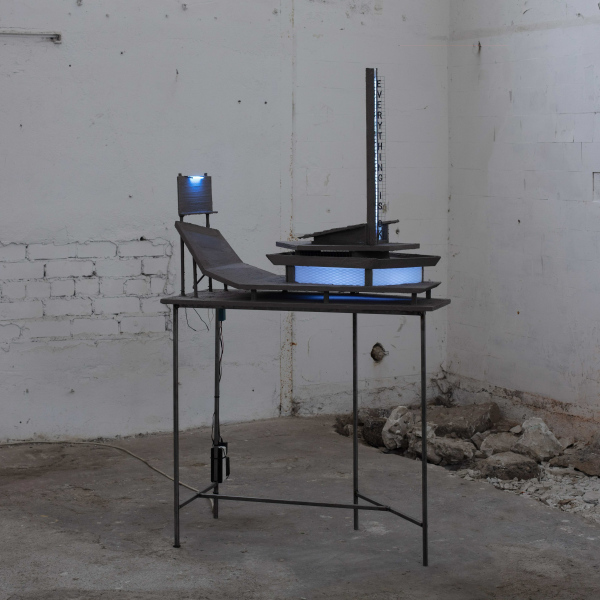
Dzelde Mierkalne
Doom Doom Delight
04.04 - 04.05.2024
Saka, ka otrā pusē zāle vienmēr esot zaļāka…, bet kas notiek, ja tāda otra puse nemaz nepastāv vai kad zāle ir zaļāka tikai tādēļ, ka tā ir mākslīga? Jaunā paaudze pilnībā apzinās apstākļus otrā pusē. Viņus nepārliecina radītie maldi, ka viss būšot kārtībā. Nākotne ir grūtībās. Viņu nākotne ir grūtībās. Un, atšķirībā no citām, Z paaudze ir guvusi mācību, kurai iepriekšējās, iespējams, bija pārāk naivas, lai pieņemtu – cilvēce nav spējīga pati sevi izglābt, nepastāv tāda “zaļākā” puse un vienīgo labumu mēs varam gūt vēl tikai un vienīgi šobrīd. Z paaudze ir reālistiska. Sarežģītie fakti, no kuriem iepriekšējās paaudzes ir vairījušās, sāk piedzīvot konfrontāciju.
Dzelde Mierkalne un viņas mākslinieciskā prakse savā būtībā iemieso Z paaudzi. Viņa nekad nav vairījusies sarežģītu jautājumu, tā vietā izvēloties tiem stāties pretī. Iepriekš pētījusi tādas tēmas kā nāve un to, kā mēs kā sabiedrība (ne)tiekam galā ar tās neizbēgamību. Izstādē “Doom Doom Delight” viņa dodas vēl dziļāk – caur savu māksliniecisko valodu reflektējot par cilvēku sugas izzušanu. Uzaugt līdzās mirstošai planētai nozīmē neiespējamību no šīs jau nolemtās nākotnes izvairīties un neizbēgami noved pie meklējumiem, kā piedalīties spēlē, kas jau zaudēta. Globālās pandēmijas, zudušo demokrātiju, karu un attīstošās klimata krīzes ēnā solījumi par cerīgu nākotni kļūst tukši, iezīmējot ceļu uz neizbēgamo. Pasaule virzās ātri, ātrāk nekā jebkad iepriekš. Tā burtiski soļo uz degošu pirkstu galiem, tādēļ Z paaudze ir sākusi veikt secinājumus par pašas cilvēces nākotni. Iekšējā attālināšanās rodas no aizvien augošā emocionālā un psihiskā nejutīguma, ik dienu saskaroties ar nebeidzamu bezcerīgu ziņu plūsmu. Pasaule, kurā vienaldzība un neapmierinātība turpina pieaugt, pieprasa saviļņojošus baudas stimulus, lai cilvēce joprojām mēģinātu izbaudīt tās “attīstību”. Šo pieeju nevajadzētu pārprast kā vienkāršu bēgšanu, pesimismu vai pat cinismu, bet gan drīzāk kā nebeidzamu izdzīvošanas režīmu. Iedomātā mākslīgās zāles ainavā fikcija un realitāte saplūst atsvešinātā, paralēlā pasaulē. Kamēr atrakciju parkos, kā Disnejlenda, drūmums sāk lauzties cauri spožās plastmasas virspuses plaisām, Mierkalne zīmē pasauli, kas nenoliedz mūsu skarbo realitāti, bet gan uzsver dzīves trauslumu un īslaicīgumu. Caur hiperreālistisku valodu, ko iedvesmojuši nāves rituāli un bauda, māksliniece ataino jaunās paaudzes apziņu par savu nenozīmīgumu. Jā, zāle rīt varētu būt zaļāka, taču pat spilgtā mākslīgās zāles nokrāsa izgaist, līdzko saule uzaustot to apspīd…
Kurators: Edvards Shautens
Producenti: Kristīne Ercika, Andris Freibergs un Viktorija Vēbere
Gaismas un tehniskais atbalsts: Maksimilians Kotovičs
Grafiskais dizains: Andris Kaļiņins
Atbalsta: Valsts kultūrkapitāla fonds, Rīgas dome un RILAK
Doom Doom Delight
They say the grass is always greener on the other side… but what happens when there is no other side, or when the grass is only greener because it's artificial? There's a new generation that is fully aware of the conditions on the other side and they are not deceived by the fairytale that it's all going to be alright. Generation Z is painfully realistic. Difficult facts, dodged by previous generations, are being confronted, accepted and simply embraced as reality.
Dzelde Mierkalne and her artistic practice are quintessentially Generation Z. She has never avoided difficult questions, choosing instead to confront and embrace them. In the past, her work has explored topics around death and how we, as a society, deal with its inevitability. For “Doom Doom Delight” she goes further. She adds to her artistic language, using it to enquire into an even more fundamental ending: that of the human species. Growing up with a dying planet implies the inescapability of a doomed future and inevitably leads to the quest of finding modes on how to play a game that has been lost. In the shadow of a global pandemic, failed democracies, a new wave of wars, and the progressing climate crisis, promises of a rosy future are being unveiled as empty words marking the path into the inevitable. The world moves fast, faster than ever and with that world at their literal fingertips, Generation Z has begun to draw conclusions about the future of humanity. The resulting faineance derives from an emotional and psychic numbness in face of a never ending streak of bad news. A world of indifference and dissatisfaction calls for thrilling stimuli of relish in order to still enjoy the ride. This fun as salvation approach shouldn’t be misunderstood as merely escapism, pessimism or even cynicism but rather a handling of an endless survival mode. In an imaginary landscape of fake grass, fake marble and fake candles fiction and reality merge into an alienated, parallel world. While in amusement parks as Disneyland bleakness bursts through the cracks of a shiny plastic superficiality, Mierkalne draws a world that doesn’t negate our harsh realities, but instead emphasizes the fragility and transience of life. Through a hyperrealistic language inspired by rituals of death as well as enjoyment the artist depicts the approach of a young generation that understands their own insignificance. Yes, the grass might be greener tomorrow, but even the bright shade of fake grass fades when exposed to sunlight.
Curator: Edd Schouten
Production: Kristīne Ercika, Andris Freibergs and Viktoria Weber
Light Design and Technical Support: Maksimilians Kotovičs
Graphic design: Andris Kaļiņins
Supported by: State Culture Capital Foundation of Latvia, Rigas Dome and Rilak Paints.
Photography Kristīne Madjare

Kaspars Groševs
Café de Paris
29.02 - 30.03.2024
Izstādē “Café de Paris” Kaspars Groševs apcer vilinošās bēgšanas no ikdienas dzīves trivialitāti, eksperimentāli spēlējoties ar atpazīstamām kompozīcijām, kā arī izceļot atšķirību starp telpas interjeru un eksterjeru. Darbi, kas izvietoti pie TUR_telpas kuba sienām, ataino glezniecības stilu, kuru var uztvert kā tradicionālo, konvencionālo glezniecības doktrīnu iztaujāšanu, to noraidījumu un atteikšanos no stereotipiskas estētikas gaidām interjerā. Šīs gleznotās ironiskās subversijas atspoguļo pieredzi bāros, kurus Groševs apmeklējis, pavadot laiku rezidencē Parīzē; attēlus, kurus nav iespējams iemūžināt fotogrāfijā un kuri gleznošanas brīdī atrodas vienīgi atmiņā. TUR_telpas transformācija par vietu starp romantisko, pārmērību un vientulību ir gluži kā Groševa radošās prakses rokraksts. Bārs kā pašpietiekama drošības, izolācijas un iedvesmas telpa.
Kurators: Edvards Shautens
Producenti: Kristīne Ercika, Andris Freibergs un Viktorija Vēbere
Gaismas un tehniskais atbalsts: Maksimilians Kotovičs
Grafiskais dizains: Andris Kaļiņins
Īpašs paldies: Inga Erdmane, LCCA un Ezītis Miglā
Atbalsta: Valsts kultūrkapitāla fonds, Rīgas dome, Tu jau zini Kur, Angārs un RILAK
Café de Paris
For “Café de Paris,” Kaspars Groševs illustrates the seductive getaways from the triviality of daily life by playing with familiar compositions in a subversive manner as well as highlighting the differentiation between exterior and interior. On the walls of the cafe created in the cube at TUR_telpa is a style of painting that must be understood as a rejection of traditional, conventional painting doctrines and a refusal of the expectations for stereotypical aesthetics in painting. These ironic subversions reflect painted experiences from bars Groševs frequented during his recent artist residency in Paris, images that cannot be captured through photography and are situated in memory at the time of painting. The transformation of TUR_telpa to one of those places between romance, excess and solitude, can be understood as exemplary for Groševs practice. The bar as a self contained space of safety, escape and inspiration.
Curator: Edd Schouten
Production: Kristīne Ercika, Andris Freibergs and Viktoria Weber
Light Design and Technical Support: Maksimilians Kotovičs
Graphic design: Andris Kaļiņins
Special thanks: Inga Erdmane, LCCA and Ezitis Migla
Supported by: State Culture Capital Foundation of Latvia, Rigas Dome, Tu jau zini Kur, Angārs, and Rilak Paints
Photography Kristīne Madjare

Luīze Rukšāne
Locījuma vietas
18.01 - 17.02.2024
Izstādei TUR_telpā Luīze Rukšāne ir izveidojusi ziemas ainavu abstrakciju, ko spētu atpazīt gan viņas vecmāmiņa, gan daudzas paaudzes pirms tās. Līdztekus mājai kā drošības un miera pilnai patvēruma vietai varam iztēloties ikdienišķo rituālu, kad lūkojamies ārā pa logu, lai pārbaudītu, kādi ir šīs dienas laikapstākļi: bargs un dzestrs ziemas aukstums, apledojusi zeme, bērzu birzs, kas pazūd baltā horizonta miglā. Rukšāne šo ikdienišķo darbību ir izmantojusi kā sākumpunktu, lai pētītu attiecības ar savu vecmāmiņu caur māksliniecisko valodu. Ar tās palīdzību viņa reflektē par attiecībām starp dažādām paaudzēm un skrienošā laika radīto īslaicīguma sajūtu.
Lielizmēra grafīta zīmējumi uz audekla ir interpretācija vecmāmiņas sūtītajām fotogrāfijām, kas uzņemtas ar planšetdatoru, lai informētu par ikdienas notikumiem savās lauku mājās. Šie zīmējumi iemieso savstarpējo apmaiņu starp vecmāmiņu un mazmeitu, skatot attiecību trauslumu ar gados vecākiem cilvēkiem un steidzamības sajūtu uzdot tiem visus būtiskos jautājumus; izzināt no kurienes nākam un kā esam audzināti. Informācija, kas tiek nodota no paaudzes paaudzē, piedzīvo dabiskas pārmaiņas, gluži kā DNS pavedieni, kas ikkatru reizi, nodoti tālāk, nedaudz izmainās. Garie baneriem līdzīgie mākslas darbi ir veidoti no tekstilmateriāla, kas piederējis kādai jau aizgājušai sievietei. Rūpīgi glabātie palagi, galdauti un nerealizētie auduma gabali pēc viņas nāves kļuvuši lieki, tādēļ Rukšāne uzmanīgi un ar cieņu tos pārveido un vienlaikus caur tiem pēta, kā kaut kas, nodots no paaudzes paaudzē, var saglabāt vērtību pat tad, ja tas tiek izmainīts līdzās mainīgajam laika ritējumam.
Kurators: Edvards Shautens
Producente: Kristīne Ercika
Producentes asistents: Andris Freibergs
Gaismas un tehniskais atbalsts: Maksimilians Kotovičs
Grafiskais dizains: Andris Kaļiņins
Atbalsta: Valsts kultūrkapitāla fonds, Rīgas dome, Tu jau zini Kur, Angārs un RILAK
Folding Lines
Luīze Rukšāne has merged the space of TUR_telpa with an abstraction of the winter landscapes her grandmother and the many generations of Latvian grandmothers before her might recognize. Around the relative shelter of the home we can imagine the daily ritual of peering out the window to check the conditions of the day: the harsh unrelenting winter cold, frozen ground, leafless birch tree forests disappearing into the haze of a white horizon. Rukšāne has used the every-day action of her grandmother looking out the window as a departure point for her artistic exploration into their relationship. By extension, it reflects on the relationship we all have with the oldest generation and the sense of transience caused by the limitation of passing time.
Her large graphite drawings on canvas are an interpretation of her grandmother's digital tablet photos sent to the family chat to inform about the daily conditions around her countryside home. The drawings embody the exchange between grandmother and granddaughter. The subject matter might seem trivial, but in them is expressed something more fundamental: the sense of urgency to ask all the important questions before it is too late, to learn the wisdom, but also the source of trauma that lies buried deep. The information passed on from generation to generation, like strands of DNA they are altered a little each time it is passed on, small alterations, little diversions and with every generation, a little of the previous ones is lost. The long banner-like textile works are made with the textiles of an anonymous elderly woman whose diligently maintained bed sheets and tablecloths became redundant after her death. Rukšāne carefully, respectfully, repurposed the textiles and through it explored how something passed down can retain value even when it is altered to satisfy changing circumstances.
Curator: Edd Schouten
Production: Kristīne Ercika
Production support: Andris Freibergs
Cube exterior and interior: Matiss Aboliņš
Light Design and Technical Support: Maksimilians Kotovičs
Graphic design: Andris Kaļiņins
Supported by: State Culture Capital Foundation of Latvia, Rigas Dome, Tu jau zini kur, Angārs and Rilak Paints.
Photography Kristīne Madjare

Jānis Dzirnieks
Optimized Flow
10.08 - 09.09.2023
Izstādes atbalstītāji: Valsts kultūrkapitāla fonds, Rīgas Dome, RILAK Rīgas laku un krāsu rūpnīca, Tu jau zini Kur.
Supported by: State Culture Capital Foundation of Latvia, Rīgas Dome, RILAK Paints, Tu jau zini Kur.
Photography Kristīne Madjare
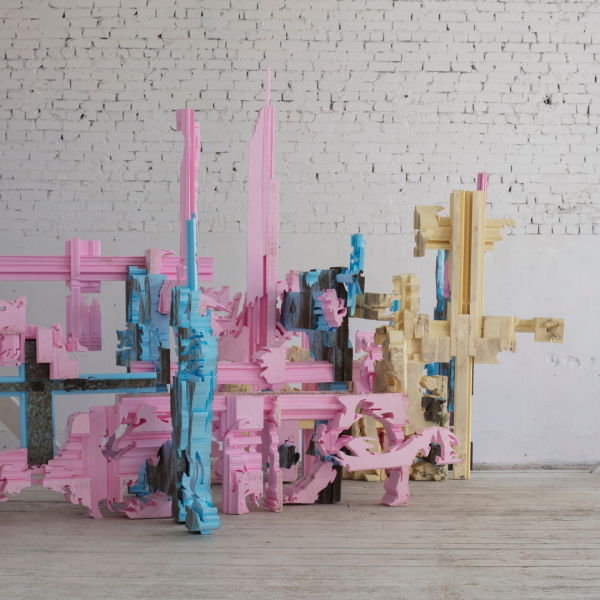
Anna Malicka
StiTcHeS of iTcHeS
06.07 - 05.08.2023
Šujmašīnas tehno ritmā Anna Malicka veidoja izšūtus, abstraktus zīmējumus un skices. Izstādei viņa radīja slāņus, kopā šujot ne tikai audumu, bet arī savas personīgās un mākslinieciskās pieredzes nogulsnes. Anna savos darbos ietver dažādus paškonstruētus tēlus, kas bieži vien reflektē par viņas haotisko "es" un kas ietekmē mākslinieces radīšanas procesu: saviesību čixe, radikālais bēbis, nereālā aģente, kā arī citus, bieži vien personiskus elementus, kas radušies no nišas kultūrām ar kurām Malicka cieši identificējas. Viņas radītie slāņi ir gan fizisko materiālu - tekstila, diegu, polsterējuma - apkopojums, gan arī iezīmes, kas atspoguļo mākslinieces sociālo, māksliniecisko un privāto identitāti. Ar saviem darbiem Anna Malicka cenšas radīt telpas, kas atrodas starp reālo un iedomāto - "nereālais īpašums", kā to dēvē pati māksliniece, rada telpu, no kuras viņa pavērš pa pusei konfrontējošu spoguli realitātei. Tā ir vieta, kurā Anna jūtas ērti, vieta, kurā viņa var saglabāt savu būtību, nestājoties pretī ierastajai realitātei. Malicka un viņas pārstāvētais dīdžeju kolektīvs PR0_Bi$TR0 papildināja izstādi ar audio slāni - smagās deju mūzikas, popmūzikas un tautas mūzikas kolāžu, lai izaicinātu StiTcHeS of iTcHeS" apmeklētāju.
Kurators: Edvards Shautens
Gaismas dizains: Maksimilians Kotovičs
Tehniskais atbalsts: Maksimilians Kotovičs
Producente: Kristīne Ercika
Skaņa: PR0_Bi$TR0 (Otra Pussyte, BMW AUDI & dj verynice) un bistro viesis dj Limpo
Paldies Elīnai Mekšai, Andrim Kaļiņinam un Katrīnai Ievai.
Izstādi atbalstīja: Valsts kultūrkapitāla fonds, Rīgas Dome, RILAK Rīgas laku un krāsu rūpnīca, Latvijas Mākslas akadēmija, Tu jau zini kur.
StiTcHeS of iTcHeS
To the techno rhythm of the sewing machine Anna Malicka crafts patchworks of embroidered abstract drawings and sketches. She assembles layers, stitching together the fabric but also the sediments of her personal, artistic experience. Within her work she weaves a veiled variety of self constructed characters, often reflections of her chaotic self, that inform her process: the party gurl, the radical baby; the unreal agent; and other, often personal elements, informed by the niche youth culture she identifies strongly with. The layers that she creates are both an assemblage of the physical materials - textile, sewing thread, upholstery - and, the traits that reflect her social, artistic and private identities. Through her work, Anna Malicka seeks to create spaces that are in between the real and the imaginary. This “unreal estate,” as she calls it, creates a space from which she can hold a semi-confrontational mirror up to reality. It is a place from where she feels a level of comfort, from where she can remain herself without having to answer to more conventional forces of reality. Tying the monumental textile works together with the space, Malicka and her all women dj collective - PR0_Bi$TR0 - put down a layer of hard dance, pop and folk music to cut, accompany and challenge the visitor to the experience of her “StiTcHeS of iTcHeS.”
Curator: Edd Schouten
Light Design and Technical Support: Maksimilians Kotovičs
Production: Kristīne Ercika
Sound: PR0_Bi$TR0 (Otra Pussyte, BMW AUDI & dj verynice) and bistro guest dj Limpo
Thank you: Elīna Mekša, Andris Kaļiņins and Katrīna Ieva
Supported by: State Culture Capital Foundation of Latvia, Latvian Academy of Art, Rigas Dome, Tu jau zini kur, Rilak Paints.
Photography Kristīne Madjare

Rūdolfs Štamers
Balsis manās galvās
01.06-01.07.2023
Rūdolfa Štamera telpu apņemošā instalācija ieveda TUR_telpa skatītāju viņa galvās. Šīs galvas, par kurām mākslinieks reflektēja izstādē ir pieredzes - it kā dažādas personības, kas mīt viņā. Savukārt balsis ir atsauce uz duālajām ietekmēm, ar kurām Rūdolfs saskaras savā dzīvē - no vienas puses vienaudžu un mākslinieku iedvesmojošās ietekmes, viņa interese materiālos un ready-made objektos, no otras, cīņa ar depresīvajām domām, ko izraisa gan viņa paša mākslininieciskās krīzes dzīvojot Parīzē, gan dažādi globālie notikumi mūsdienu pasaulē.
Izstādē TUR_telpā Štamers domas, ko satiek viņa dažādās personības, pārveidojalielizmēra skulpturālos gleznojumos, kas radīti no pārstrādātiem reklāmas baneriem. Šie gleznojumi stiepās no viena telpas stūra uz otru, augšup un lejup, pa visu izstādes telpu, mijedarbojoties ar viņa ready-made skulptūrām, intervencēm un dažādiem sensoriem elementiem, piemēram, skaņu vai smaržu.
Sev tik raksturīgajā manierē Štamers radīja sirreālu gaisotni un spēlējās ar sapņainumu, kura uztveršanā tiek iesaistītas visas maņas - viņš aicināja apmeklētāju sapņot par savas zemapziņas alkām. Štamera radīto kontrolēto haosu paspilgtināja viņa mākslinieciskie iedvesmotāji - Sabīne Vernere, Uģis Albiņš un OFF ME ON/ Diana Payton, kuri, mijiedrabojoties ar viņa darbu, veidoja reizē harmoniju vai disonansi, atkarībā no vērotāja perspektīvas. Arī pats vērotājs šeit kļuva par instalācijas sastāvdaļu un papildināja to radot jaunas “balsis.”
Kurators: Edvards Shautens
Producente: Kristīne Ercika
Izstādes mediators: Andris Freibergs
Gaismas dizains: Maksimilians Kotovičs
Tehniskais atbalsts: Uldis Trapencieris un Maksimilians Kotovičs
Izstādi atbalstīja: Valsts kultūrkapitāla fonds, VV Foundation, Rīgas Dome, Tu jau zini kur, SPICE, RILAK Rīgas laku un krāsu rūpnīca.
Voices in My Heads
Rūdolfs Štamers space engulfing installation invites the viewer into the voices in his heads. His heads are his experiences with what feel like different personalities residing inside him; the voices refer to the dual influences he faces in his life. On the one hand, the inspirational impact of his peers, other artists, his interest in readymades and the materials he encounters. On the other hand, the darker and more sinister influence of his pessimistic thoughts caused by personal artistic crises exacerbated by the depressing global events of the times in which we live. At TUR_telpa he brings together the impressions his various personalities encounter in the form of large scale sculptural paintings made of repurposed advertising banners extending from corner to corner, up and down across the exhibition space and interlaced with his ready made sculptures, interventions and other sensory elements like sound and smell. In the characteristic typical of Štamers, he creates surrealistic ambiance where all senses are engaged, playing with a dreamlike aura that invites the visitor into a daydream about our subconscious cravings. The orchestrated chaos is amplified through the interventions of several of his artistic inspirations, works by Sabine Vernere, Uģis Albinš and OFF ME ON (Diana Payton) interact, creating harmony and dissonance depending on the perspective from which they are perceived. It is the visitor that completes the installation - their presence creating yet another one of the many “voices in my heads.”
Curator: Edd Schouten
Production: Kristīne Ercika
Light Design: Maksimilians Kotovičs
Technical Support: Uldis Trapencieris and Maksimilians Kotovičs
Supported by: State Culture Capital Foundation of Latvia, VV Foundation, Tu Tau Zini Kur, Rigas Dome, SPICE, Rilak Paints.
Photography by Rūdolfs Štamers and Filips Smits

Maija Kurševa
Lapa uz lapas
30.03 - 29.04.2023
Gandrīz 300 ar laku uz puscaurspīdīga zīdpapīra veidotie zīmējumi liegi šūpojas smalkā koka konstrukcijā. Katrs zīmējums ir savrupas papīra lapas kustības mirklis, tai šūpojoties no sākuma līdz beigām un vēlreiz atgriežoties sākuma punktā. Klasiskās animācijas tehnikā, kur ik kadrs veidots no atsevišķiem zīmējumiem, uz sienas rodas projicēta cilpa. Summējoties šie animācijas kadri, kas tika eksponēti kā atsevišķi zīmējumi telpā un kā animācijas cilpa, radīja sajūtu par telpas dinamiku un laika telpiskumu.
Kustība, kas izpētīta un tad nofiksēta cilpā. Aiz šīs instalācijas šķietamās vienkāršības slēpjas rūpīgs un apzināts process, kurā tikusi meklēta un atrasta vēlamā kustība; katrs mirklis ticis filmēts un pēc tam animēts; katrs atsevišķais kadrs pārzīmēts uz papīra lapas, kas izgriezta ar rokām; un visbeidzot katrs zīmējums nofotografēts uz gaismas galda un gala rezultāts animēts. Kā čakla skudriņa Kurševa pedantiski veikusi katru procesa soli, ar roku atkārtojot papīra griešanas žestu, velkot katras atsevišķās kustības līnijas un fotografējot katru atsevišķo lapu. Šai ziņā Maijas Kurševas darbos ir rodama rotaļīga pretruna. Šķietamais vieglums un gaisīgums, ar kādu viņa aicina skatītāju piedzīvot savu darbu, slēpj pamatīgu rūpīgumu, ko māksliniece velta ik solim radīšanas procesā.
Arī šī procesa gala posmā, izvietojot darbu unikālajā TUR_telpā, Kurševa turpināja būt skrupuloza un uzmanīga pret konceptuālām un estētiskām detaļām. Smalkā koka konstrukcija, kurā tika izvietoti zīmējumi, šķietami tikpat viegla kā paši zīmējumi, savdabīgi sasaucas ar masīvo 5 × 5 × 5 metrus lielo kubu, kas aukstajos ziemas mēnešos ir bijis TUR_telpas centrālais elements. Attēlu miglainā materialitāte – radot viegluma sajūtu un papildinot kopējo vērojuma sajūtu pieredzi – atspoguļojās arī izstādes telpas apgaismojumu filtrējošo puscaurspīdīgo virsmu blāvumā. Pat projicētajai cilpai un to uztverošajai baltajai sienai piemīt kopīgs neparasts gaisīgums, kas abām ļauj saplūst teju vienotā veselumā.
“Lapa uz lapas” ir instalācija, kuras sākums un beigas var atrasties vienā un tajā pašā vietā, kamēr telpa to starpā ir bezgalīga kā cilpa. Šī izstāde bija uzaicinājums uz vieglumu, uz laika, telpas un kustības rāmu apceri.
Kurators: Evards Shautens
Tehniskais atbalsts: Uldis Trapencieris un Maksimilians Kotovičs
Producente: Džesika Petere
Izstādi atbalstīja: Valsts Kultūrkapitāla fonds
Sheet on Sheet
Nearly 300 drawings made with varnish on semi transparent paper gently sway from an intricate wooden structure. Each drawing is a moment of movement of a solitary sheet of paper as it swings from beginning to end to beginning again. A frame by frame animation made up of the drawings form a loop projected on the wall. Together, these frames of animation presented as drawings in space and as a projected loop create a sense of dynamization of space and spatialization of time.
A movement explored and then captured in a loop. The seeming simplicity of the installation hides a conscientious process of finding a satisfying movement; filming and then animating each moment; transcribing each individual frame on a sheet of paper cut out by hand; and finally photographing each drawing on a light box and animating the result. Like an ant, Kurševa executed each step of the process painstakingly, repeating the gesture of cutting paper by hand, drawing the lines of each individual movement, photographing each individual sheet. In that sense there is a playful contradiction in the work of Maija Kurševa. The seeming ease and lightness with which she invites the viewer to experience the work conceal the care she takes with each and every step of her process.
With the final step in the process, placing the work in the unique space of TUR_telpa, Kurševa remains meticulous and attentive to conceptual and aesthetic details. The delicate wooden structure holding the drawings, seemingly as light as the drawings themselves, is somehow kindred to the massive 5 by 5 by 5 box that has been central to TUR_telpa during the cold winter months. The foggy materiality of the images - creating a sense of lightness and adding to the overall sensory experience - are also reflected in the opaqueness of the semi transparent surfaces that filter light into the exhibition space. Even the projected loop and the white wall that receives it seem to share an erratic quality that make it almost one.
“Sheet on Sheet” is an installation where the beginning and end can be the same place and the space in between is as endless as a loop. It is an invitation to lightness, a contemplation of time, space and movement.
Curator: Edd Schouten
Technical Support: Uldis Trapencieris and Maksimilians Kotovičs
Production: Džesika Petere
Supported by: State Culture Capital Foundation of Latvia
Photography Didzis Grodzs

Andris Kaļiņins
Baltā zāle
23.02 - 25.03.2023
Andra Kaļiņina “Baltā zāle” bija otrā izstāde TUR_telpas ziemas izstāžu ciklā “No aukstuma gaismā” un piedāvāja jaunradītas gleznas, kuras iedvesmojusi mākslinieka interese par muzejisko un glezniecības materialitāti dažādos tās aspektos.
Izmantojot visu TUR_telpu, Kaļiņins izvietoja savas gleznas abstrahētas mākslas vēstures muzeja zāles ietvarā un ļāvās rotaļīgi apspēlēt veidu, kā strukturēti Eiropas muzeji un tajos eksponētie mākslas virzieni. Ievērojamu Eiropas mākslas vēstures muzeju apmeklējumu laikā Kaļiņinu allaž īpaši intriģējušas iespaidīgās glezniecībai atvēlētās telpas. Šīs zāles kā svētnīcas krāsai un glezniecības procesam uz mākslinieku atstājušas iespaidu. Personālizstādē viņš izveidoja gleznu instalāciju, kas vienlīdz lielā mērā atsaucas gan uz muzeoloģiskām tēmām, gan mākslas virzieniem vēstures ritumā.
Kaļiņins īpaši izceļ robežšķirtni starp laiku pirms un pēc Apgaismības. Vienā zāles pusē viņš atsaucies uz laiku, kad gaisma pārtop daudzšķautņainā realitātē, ko tehnoloģiski un zinātniski aprakstījuši, citstarp, Gēte un Ņūtons. „Baltajā zālē” Kaļiņins paralēli gleznu ekspozīcijai izmantojis iespēju apcerēt gaismas, krāsas, atspīduma un absorbācijas iedarbi vienlaikus hiperreālā un abstraktā kontekstā.
Kurators: Edvards Shautens
Gaismas dizains: Maksimilians Kotovičs
Tehniskais atbalsts: Uldis Trapencieris un Maksimilians Kotovičs
Producente: Džesika Petere
Izstādi atbalstīja: Valsts Kultūrkapitāla fonds
Weißer Saal
Andris Kaļiņins' exhibition “Weißer Saal” was the second in TUR_telpa's winter series of exhibitions “From the Cold into the Light” and presented an installation of new paintings inspired by his interest in museality and the materiality of painting in its different facets.
Using the entirety of TUR_telpa, Kaļiņins placed his paintings within the context of an abstracted art history museum where he playfully refers to how European museums, and the artistic movements they display, are organized. During visits to prominent European museums dedicated to art, Kaļiņins was particularly intrigued by the impressive spaces dedicated to paintings. These spaces, like sanctuaries to the paint and the act of painting, left a permanent impression on him. At TUR_telpa he created an installation of paintings that referred as much to museological topics as to art historical movements.
Kaļiņins draws a line between the period before and after the Enlightenment. On one side he refers to the time when the divine was considered the single source of light. On the opposite side, to the period after the Enlightenment when light became a multi faceted reality described technologically and scientifically by, amongst others, Goethe and Newton. In “Weißer Saal” Kaļiņins presents paintings but also takes the opportunity to consider the effect of light, color, reflection and absorption in a context that is simultaneously hyper real and abstract.
Curator: Edd Schouten
Light Design: Maksimilians Kotovičs
Technical Support: Uldis Trapencieris and Maksimilians Kotovičs
Production: Džesika Petere
Supported by: State Culture Capital Foundation of Latvia
Photography by Inga Erdmane and Didzis Grodzs

Inga Erdmane
Neredzamās pilsētas
19.01 - 18.02.2023
Māksliniece Inga Erdmane izstādei “Neredzamās pilsētas” tika radījusi jaunu darbu, kura uzmanības centrā ir Tallinas ielas kvartāls, tā vēsture un tas, kā laika gaitā izbāl atmiņas par bijušo. Erdmanes interese par sistēmām un struktūrām bieži ir vērsta uz to robežām, kas paredz iekļūšanu novārtā atstātās teritorijās, kuru atmiņas pamestas zudībai. Darbam “Neredzamāspilsētas” viņa pētīja arhīvus, intervēja aculieciniekus no laikiem, kad Tallinas kvartāls bija sanitārā transporta autobāze, un apkopoja fotogrāfijas no privātām un publiskām kolekcijām. Jo tālāk atpakaļ laikā viņa devās, jo grūtāk kļuva rast skaidru priekšstatu par to, kā bijis agrāk.
Erdmanes interese par fotogrāfijas materialitāti viņu bieži mudina praktizēt dažādas tehnikas — šajā gadījumā pētniecības procesā atrastās fotogrāfijas ir tikušas deformētas un pakļautas ķīmiskām reakcijām. Izstādei izvēlētas pagātnē uzņemtās fotogrāfijas no Tallinas ielas kvartāla un tā apkārtnes māksliniece pārklājusi ar vēl vienu plīvuru kā atkārtotu norādi uz atmiņu izbalēšanu laika plūsmā. Kopā ar lielformāta fotogrāfijām viņa centās izstāstīt apslēptu stāstu, kas pilnībā vairs nemaz nav noskaidrojams. To aizvien ir apracis laiks, un skatītājs tika uzaicināts apcerēt, kāds šis stāsts varēja būt, iekams tas kļuva par daļu no neredzamās pilsētas, ko aizsedz pagātnes apmetnis.
Kurators: Edvards Shautens
Gaismas dizains: Maksimilians Kotovičs
Tehniskais atbalsts: Rūdolfs Štamers and Uldis Trapencieris
Producente: Džesika Petere
Izstādi atbalsta: Valsts Kultūrkapitāla fonds
Invisible Cities
For “Invisible Cities,” Inga Erdmane created new work that focussed on Tallinas Kvartāls, its history and how the memories from what was before have faded with time. In her work, Erdmane’s interest in systems and structures often concentrates on boundaries, where individuals enter spaces that are obscured or recollection is forgotten. For “Invisible Cities” she explored archives; interviewed witnesses from the time when Tallinas kvartāls was an emergency vehicle depot and garage; and collected photographs from private and public collections. The further back she went, the harder it was to get a clear picture of what was before.
Erdmane’s interest in the materiality of photography often compels her to use different techniques to create distortion and deformation of the material she works with. In this case she has obscured collected photographs taken around Tallinas Kvartāls in the past adding another veil to reiterate the fading of memory by time and its elements. Along with large format photographs she attempts to tell a hidden story which can never be completely uncovered. It remains buried by time and the viewer is invited to theorize about how it could have been before it became part of an invisible city shrouded by the past.
Curator: Edd Schouten
Light Design: Maksimilians Kotovičs
Technical Support: Rūdolfs Štamers and Uldis Trapencieris
Production: Džesika Petere
Supported by: State Culture Capital Foundation of Latvia
Photography Inga Erdmane
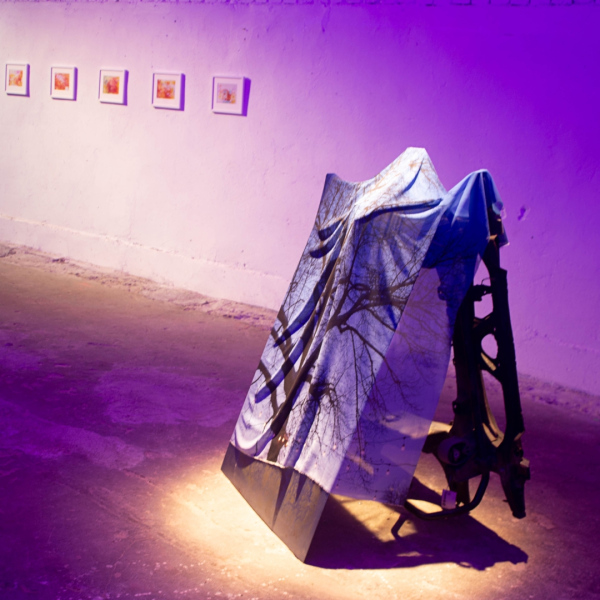
Linda Boļšakova
Ziedsēkla
06.09 - 16.09.2022
Sēkla ir kaut kas no pagātnes, kas pāraug nākotnē. Kāda ir mūsu ekoloģiju nākotne un kas nodrošinās šīs ekoloģijas uzziedēšanu? Manā pieredzē sievietes ir tās, kuras vāc, dalās un sēj mūsu nākotnes sēklas. Pirms 100 gadiem dabiskās pļavas klāja 30% Latvijas teritorijas, šodien tās ir mazāk par 1%. Dabisko pļavu nozīmīgums mīt ne tikai trejdeviņās Jāņu zālēs, kultūrvēsturiskajā mantojumā, bet arī mūsu (sa)dzīvotspējā, un tajās sastopama arī vislielākā sugu daudzveidība, kas ir viena no lielākajām vērtībām klimata krīzes apstākļos. Daudzi pļavu augi ir ārstniecības un aizsargājami augi. Mūsu vecvecmāmiņas nevarēja iedomāties, ka dabisko pļavu izdzīvošanai būs nepieciešams pļavu sēklas vākt ar rokām, lai pēc tam tās iesētu citviet, bet tas ir tieši tas, ko šobrīd dara seniores kopā ar Latvijas Dabas fonda biotopu eksperti Rūtu Sniedzi-Kretalovu, senioru iesaistes idejas iniciatori Maiju Sauļūnu un Ilgu Ancu, aktīvu sēklu lasītāju, kā arī vēl daudz siltu plaukstu. Nav grūti iztēloties, ka cilvēkam ir nepieciešamas pļavas, bet pļavai vajag arī cilvēku.
Meadowseed
The seed is something from the past that grows into the future. What is the future for our ecologies and who brings this ecology to flourishing? In my experience, women are the ones who gatherer, share and sow the seeds of our future. 100 years ago, natural meadows covered 30% of the territory of Latvia, today it is less than 1%. The importance of natural meadows resides not only in the multitude of flowers for the Jāņi midsummer celebration, the cultural and historical heritage but also in our (co)existence. Meadows are also places of the greatest diversity of species, an important factor in the face of the climate crisis. In addition to that, many meadow plants are medicinal and protected plants. Our great-grandmothers could not have imagined that for the survival of natural meadows, it would be necessary to collect meadow seeds by hand in order to sow them elsewhere, but this is exactly what older Latvian women are currently doing together with Rūta Sniedze-Kretalova, habitat expert of the Latvian Nature Foundation; Maija Sauļūna, the initiators of the idea of senior involvement; Ilga Anca, an active seed gathered; and, many more warm hands. It is not difficult to imagine that a person needs meadows, but a meadow also needs a person - ideally, a person with a herd that knows how.
Photography Lelde Gūtmane
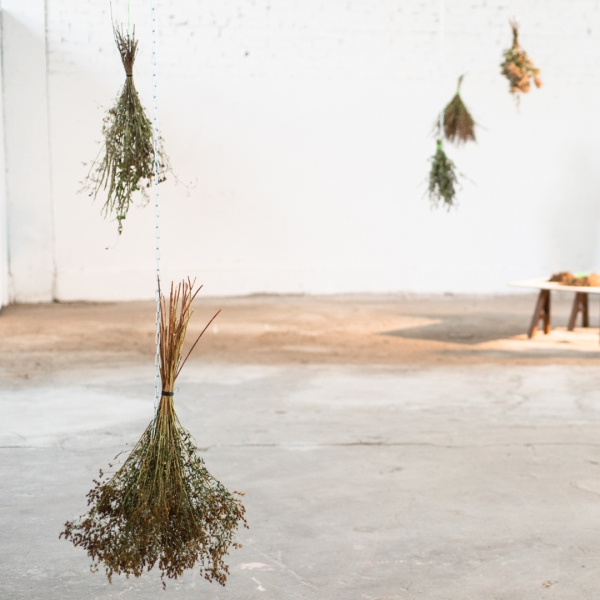
Kirils Ēcis
Balsis mūsu galvās
16.08 - 27.08.2023
Iekšējais monologs ir pastāvīgs iedzīvotājs ikkatra galvā. Tomēr apzīmējums “monologs” šķiet neprecīzs brīžos, kad balss sāk pati sevi apšaubīt. Ir grūti strīdēties ar savu galvu, jo galva ir viena, bet strīdēšanās parasti notiek starp diviem dažādiem. Un nav jau obligāti jāstrīdas, var arī vienkārši sarunāties un tā, vienkārši sarunājoties, balss, kas tikko bijusi viena un blīva, lēnām izretojas, sadaloties vairākās dažādās balsīs. Balsīs, kurām katrai ir sava izteka un virzība.
Darbs “Balsis mūsu galvās” ir apmeklētāja līdzdalībai atvērta saruna, kas pēta iekšējā dialoga, pašcenzūras un intuīcijas attiecības.
Photography Lelde Gūtmane
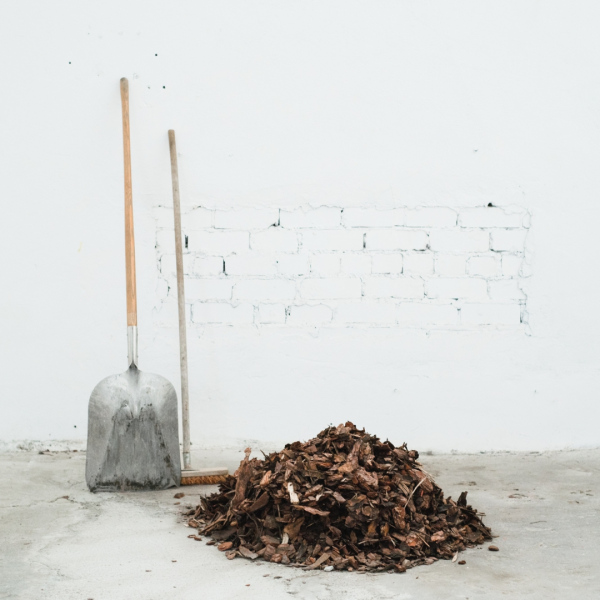
Edvards Shautens
Spatial Propositions For There (TUR)
02.08 - 13.08.2022
Edd Schouten (NL)
Spatial propositions for the space of TUR are choreographic nudges into a relationship between the viewer and the space of TUR_telpa. The drawings are inspired by the space. They are an abstract interpretation of it, the result of a dialogue between artist and space, a collaboration. In the context of the exhibition, the drawings become propositions. They become choreographic maps, scores from which the viewer might be persuaded into a tweaked encounter of space. To that effect, two experienced performers, with celebrated careers in dance, have been invited to inhabit the space and engage it. They are tasked to consider several layers of movement, the drawings being an indication of how their dance might find lines and/or shapes; speed, direction and/or duration; quality and or color. This is layered on other movement agreements - consideration of breath, weight and sense - and the performers’ personal interpretation of the space. The viewer is invited to observe and they too might consider the drawings as choreographic maps allowing themselves to be nudged into a different approach to experiencing the space, a slight tweak to how they might have been in the space of TUR_telpa before. They are propositions, propositions for there.
Performed by Andris Vītiņš and Ints Roziņš
Photography Edd Schouten and Lelde Gūtmane
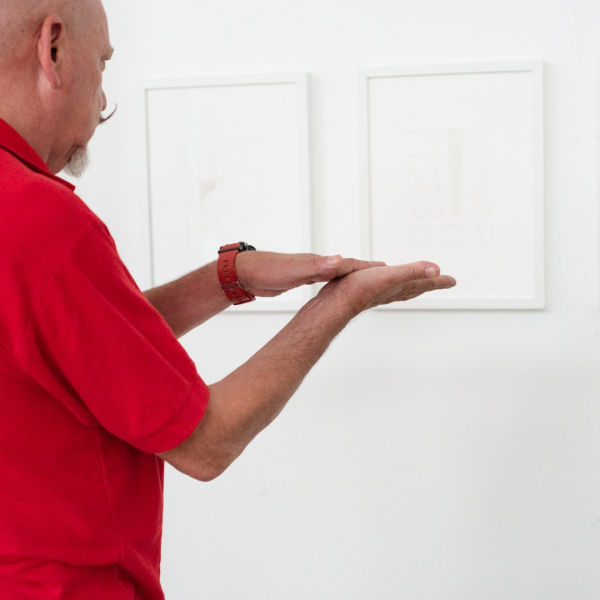
Marija Luīze Meļķe
Dejas kā sunītim
Ideas as a Dog
19.07 - 30.07.2022
Dažbrīd cilvēkam gadās apmaldīties savu ideālu, vērtību un uzskatu mezglos tā, ka kļūst grūti atbildēt uz būtiskiem jautājumiem – nav saprotams, kas ir vienlaikus taisnīgā un patiesā atbilde, kad jāņem vērā tik daudz apstākļu un konceptu. Šāds apjukums var itin kā paralizēt cilvēka sajūtas un domāšanu, gribas labāk atsvešināties, nekādus ietilpīgus jautājumus neaiztikt. Bet ir veidi, kā atgūt kustēšanās spējas, arī neaizbēgot prom pavisam. Darbā “Idejas kā sunītim” kusības atgūšanai tiek pielietots viegls absurds un perspektīvas maiņa, ko izraisa mākslinieces veidotā situācija izstādes telpā. To paredzēts uztvert tik nopietni, cik katram pašam nepieciešams; reizēm vienkārši gribas piedzīvot kaut ko neikdienišķu, un ar to ir gana.
Photography Lelde Gūtmane
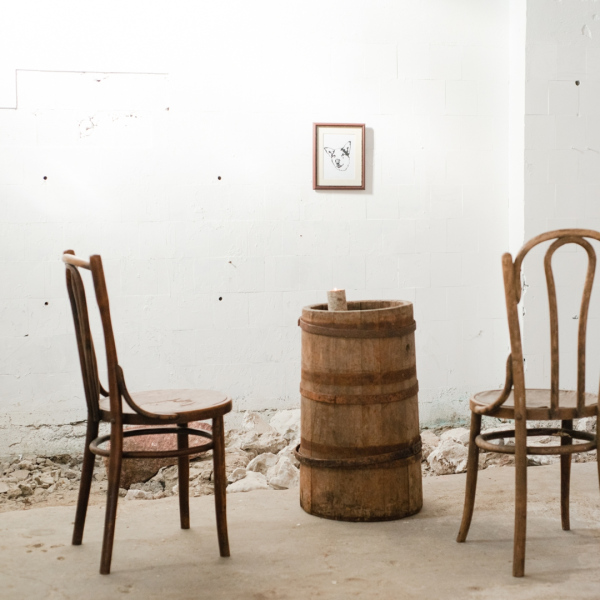
Kate Krolle, Reinis Berziņš
Lēna cūka dziļu sakni rok
05.07 - 16.07.2022
Un visbeidzot. Mēs nonācām vietā, kurā nolēmām palikt. Pāri bija palikusi pusotra ēka, lieli koki, mazliet nenokusis sniegs un visas pārējās drupas. Neviens mums neko nebija stāstījis par šo vietu. Iespējams, vieta pati bija saukusi. Izstāde veidojusies kā divu cilvēku saruna, kas materializējusies radošajā procesā. Kopīgi pieredzot pārcelšanos uz vidi, kas nosaka atgriešanos pie nosacīti primitīva sākuma, apkārtējie materiāli un darbības vienlīdz kļūst par fundamentāliem ikdienas pamatelementiem un iedvesmas avotiem. Zeme, akmens, zeme, koks, vilna, zars, zeme, jumts. Telpiski objekti mijas ar to līdzībām un atveidojumiem plaknē, piedzīvojot tālāku transformāciju nelineārā telpā.
A Slow Pig Digs Deep Roots
A slow pig digs deep roots. And finally we arrive at the place where we would settle. All that was left was one and a half buildings, some large trees, a bit of snow, and some ruins. No one had told us anything about this place. Perhaps the site itself was summoning us. The exhibition was a conversation that turned into a physical manifestation during the creative process. By co-experiencing the move to an environment that defines a return to relatively primitive beginnings, the surrounding materials and activities equally become fundamental everyday building blocks and sources of inspiration. Earth, stone, wood, wool, branches, materials for a roof. Spatial objects alternate with their likenesses and representations on the plane, undergoing further transformation in non-linear space.
Photography Lelde Gūtmane
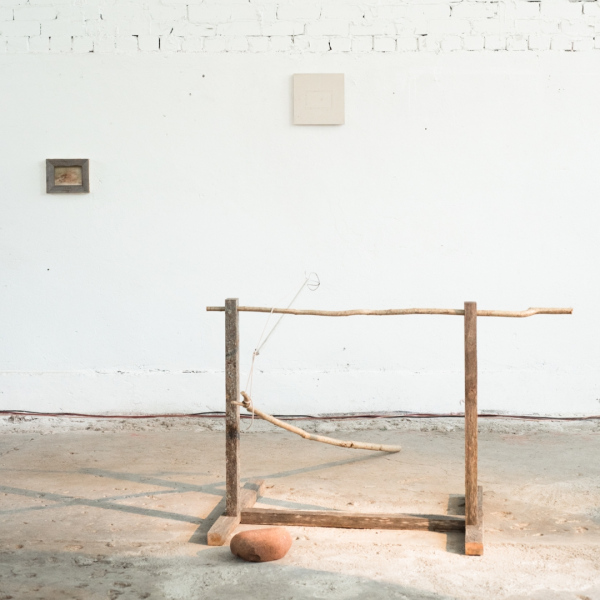
Krišjānis Elviks
- - saki - ko man darīt - - - nesaki - ko man darīt
16.05 - 21.05.2022
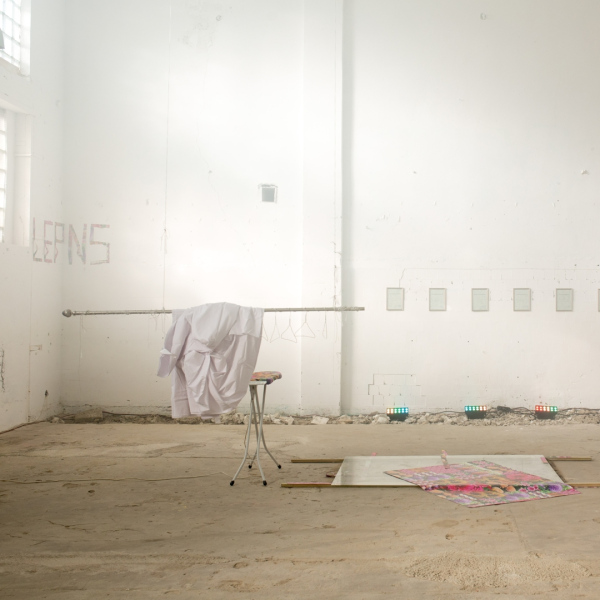
Kristīne Krauze Slucka
Piespiedu pagātnes kustības
20.04 - 01.05.2022
Forced Movements of the Past
“Forced Movements of the Past” is based on a sense of time and space about the destructive nature of war. “Arte povera”, or the so-called “art of poor materials”, refers not that much to the use of poor materials or a self-righteous sociological critique of society but rather an attempt to confront and reveal the experience of the human world. The recycled felt used in the installation – created by compressing the fibres of shredded fabrics – depicts a trauma that leaves an indelible mark on the individual’s personality. It is a landscape of fragmented identity that seeks to regain wholeness; these are the conditions that force one to transform and become the Other. A soundtrack by Kaspars Jaudzems accompanies the installation and integrates intercepted messages from Russian soldiers on the front line and recordings of calls with the soldiers’ families back home.
Krauze-Slucka’s choice of material, industrial pressed wool felts, plays an especially important role in the theme of the show. Marilyn Frye takes us back to the root of the word oppression, which is from press: “The press of the crowd; pressed into military service; to press a pair of pants; printing press; press the button. Presses are used to mold things or flatten them or reduce them in bulk, sometimes to reduce them by squeezing out the gases or liquids in them. Something pressed is something caught between or among forces and barriers which are so related to each other that jointly they restrain, restrict or prevent the thing’s motion or mobility. Mold. Immobilize. Reduce.” (1983,54)
Photography and video Krtstīne Krauze Slucka
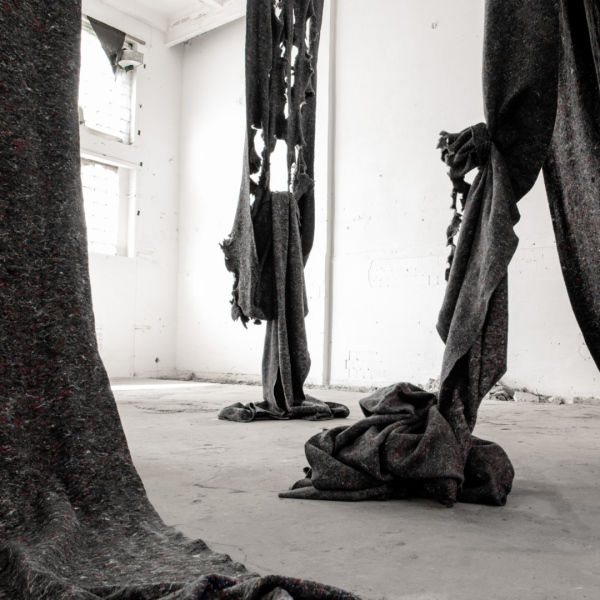
Sabīne Vernere
O
12.10 - 24.10.2021
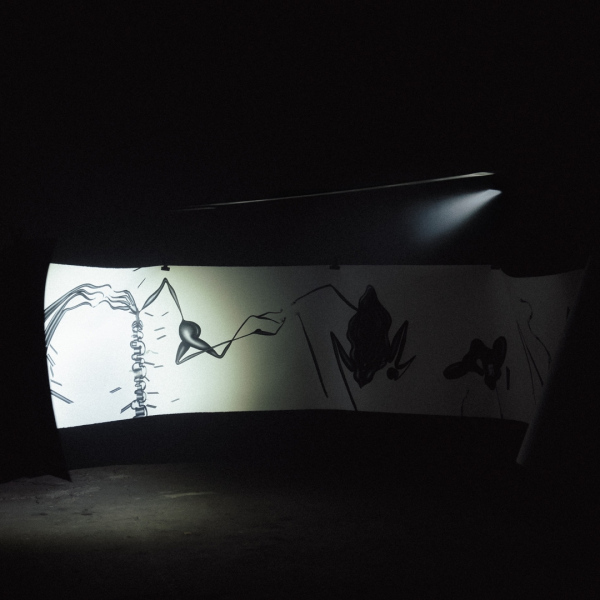
Uģis Albiņš
Rumolda Parks
22.09 - 03.10.2021
For Rumolda Park, Albiņš explored efforts to solve everyday problems using techniques rooted in the engineering and design industries. Drawing inspiration from the aesthetics of household and manufacturing industries, these solutions offer an abstract perspective on cultural features, time-specific consciousness, and a shared understanding of how mechanisms function.
Industrial design manifests in countless forms in daily life. These forms are unified by their adherence to the principles of form and function, alongside the aesthetic and cultural preferences of their target audience. This design logic ensures that forms are shaped by the specific materiality and embodiment required to fulfill their intended functions.
Many industrial household objects, while primarily designed to meet practical needs, incorporate an understated aesthetic that feels both self-evident and commonplace to the consumer. These objects are rarely adorned with decorative embellishments. Instead, subtle design choices—such as concave lines that break rigid straightness—add an elegant touch.
This design influence extends to household items, where shapes and streamlines evoke a sense of movement, as though heading toward a destination or returning from one.

Kristiāna Marija Sproģe
Polikutūras
02.09 - 12.09.2021
Photography Lelde Gūtmane
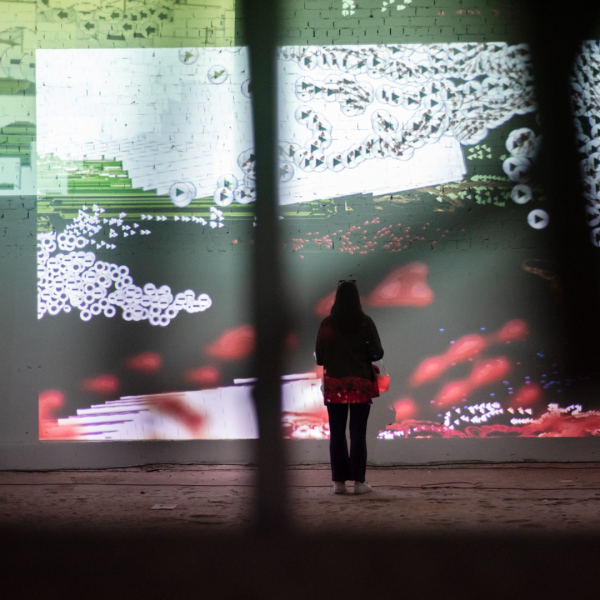
Alise Sondōre
Blues Cruise
14.07 - 25.07.2021
Photography Elizabete Ezergaile
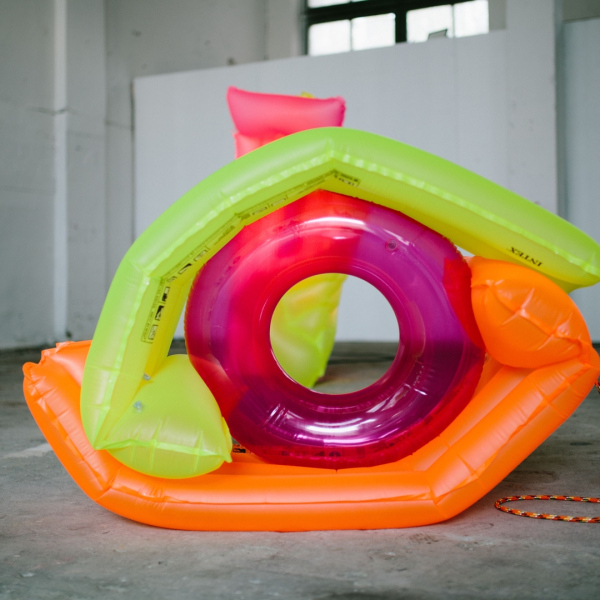
Reinis Lodziņš
Tallinas ledājs
30.06 - 11.07.2021

Pauls Rietums
C - C - C - C - C - C
07.06 - 20.06.2022
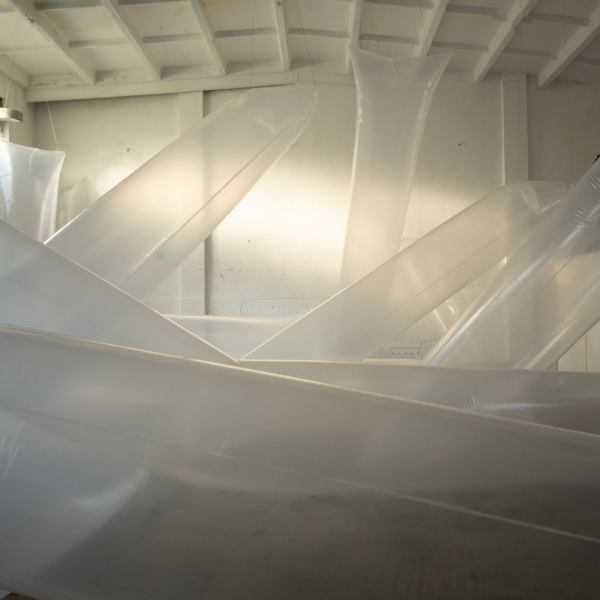
Miķelis Mūrnieks
Visual Pleasure Theory
25.05 - 06.06.2021
"Vīrieši sapņo par sievietēm. Sievietes sapņo par to, ka par viņām sapņo kāds cits. Vīrieši skatās uz sievietēm. Sievietes vēro, kā uz viņām skatās kāds cits. Viņas konstanti sastop skatienus, kas strādā kā spoguļi, atgādinot viņām to, kā viņas izskatās – vai kā viņām vajadzētu izskatīties," ar šiem vārdiem 1972. gadā britu mākslas kritiķis Džons Bergers aizsāka male gaze jeb "vīrieša skatiena" problēmas pētniecību. Dažus gadus vēlāk kino teorētiķe Lora Malveja definēja, ka "Sievietes loma patriarhālā sabiedrībā ir būt par simbolu vīrieša uztverē, eksistēt kā objektam, caur kuru vīrietis var izdzīvot savas fantāzijas un apsēstības [..], uzspiežot tās sievietes klusējošajam tēlam, kuras loma ir izteikt kaut kā nozīmi, nevis to radīt."
Šī perspektīva turpina rezonēt arī piecdesmit gadus vēlāk, un Miķeļa Mūrnieka izstāde to apliecina, nostādot savādā situācijā ne tikai skatītāju, bet vispirms jau pašu mākslinieku. Darbu sērijā redzamas divpadsmit skaistas, kailas sievietes, divpadsmit ikoniskas apustules, kas izkārtotas specifiski sakrālā telpas ģeometrijā. Vai Mūrnieka darbi iemieso "vīrieša skatiena" problēmas kodolu? Vai tie ļauj uz to paraudzīties no jaunas perspektīvas? Vairāki izstādes darbi atsaucas uz antīkās un kristīgās kultūras tēliem – Ticiāna Venēru, trim skaistuma dievietēm un kristietības simboliem –, kas piesūkušies ar patriarhālisma tumšo smagumu. Kā uz abstraktajiem aktiem skatīties caur feminisma prizmu? Vai vīrietis mākslinieks vispār ir spējīgs norādīt uz sievietes skaistumu, nepadarot to par objektu? Un kas konstruē šīs izstādes skatienu?
Darbu sērijas tapšanu rosinājusi vēlme pārskatīt estētikas ideālus, un tas novedis pie Mūrniekam raksturīgas šķīsti nekautrīgas atklāsmes: sievietes kailais ķermenis viņa acīs ir skaistuma augstākā virsotne. Tiekšanos pēc estētiskās baudas atspoguļo darbu vizuālā valoda, kas stilistiski līdzinās Art Deco dekoratīvajai elegancei; formas ziņā sēriju spēcīgi ietekmējis franču arhitekta Ektora Gimāra jūgendstils.
Šķetinot izstādes slāņus, pakāpeniski atklājas simboliska, niansēta pretestība ilustratīvajam, objektificējošajam vīrieša skatījumam – to iemieso darbu vizuālā abstrakcija un izmantoto materiālu savstarpējais konflikts. Skrupulozi veidotajām metāla formām un lateksam cauri spiežas poliuretāna putas – Mūrnieka autortehnika sieviešu tēlu nopulētajās ķermeņa daļās atstājusi brūces, rētas un strijas.
Taču pats pretestības, mulsuma un pārdzīvojuma kodols atrodas izstādes centrā esošajā tituldarbā – konstrukcijā, kas veido atsvaru Mūrnieka vizuālā baudījuma teorijas skaistumam – reizē konceptuāli, burtiski un fiziski. Varbūt skaistuma apbrīnas pretpolu veido joprojām sastopamais šovinisms vai apjausma par saviem grēkiem? Varbūt šie jautājumi ir smagāki par nevainīgu baudījumu? Jebkurā gadījumā – šķiet svarīgi par to uzsākt sarunu. Pat tad, ja bail, ka domas ceļš draud izvērsties par apropriāciju.
Bergers norāda, ka Eiropas gleznās kailums sākotnēji parādījās caur Ādama un Ievas stāstu. Vecajā derībā čūska Ievu vilina ēst aizliegto augli, sakot: "Jūs noteikti nemirsit, jo Dievs zina, ka tanī dienā, kad jūs no tā ēdīsit, tad jūsu acis taps atvērtas un jūs būsit kā Dievi, zinādami labu un ļaunu." Ieva iekožas ābolā, dod to Ādamam, un tad "viņu abu acis tapa atvērtas, un viņi zināja, ka viņi bija kaili. Un viņi sašuva vīģu lapas kopā un darīja sev priekšautus". Kailums kļuva grēcīgs brīdī, kad tapa ieraudzīts.
Miķeļa Mūrnieka darbi turpina provocēt ar simbolu blīvumu – klusējošie tēli neskatās vērotājam acīs, bet padara kailu savu autoru, pavēršot pret viņu sociālās kritikas skatienu starmešus. Skatītājus noķer tikai tā atspīdums un mestās ēnas – telpā, kur ķermeņa kailums mulsina no jauna. Kaut kur starp nevainīgo laiku paradīzē, baudu un krišanu grēkā.
- Henriks Eliass Zēgners
Visual Pleasure Theory
"Men dream of women. Women dream of themselves being dreamt of. Men look at women. Women watch themselves being looked at. Women constantly meet glances which act like mirrors reminding them of how they look or how they should look," wrote the English art critic John Berger in 1972, in what was the starting point of the inquiry into the problem of the male gaze. A couple years later, film theorist Laura Mulvey stated the following: “Woman stands in patriarchal culture as a signifier for the male other, bound by a symbolic order in which man can live out his fantasies and obsessions … by imposing them on the silent image of woman still tied to her place as bearer, not maker, of meaning.”
Fifty years on, it still remains a resonant perspective, and Miķelis Mūrnieks’ exhibition confirms this, putting not just the viewer but first and foremost the artist into a strange situation. This series of works features twelve naked and beautiful women, twelve iconic apostles arranged inside a specific and sacral geometry of the exhibition space. Do Mūrnieks’ works embody the problem of the male gaze? Do they show it from a new perspective? Several of the works on show refer to images of ancient and Christian culture – Titian’s Venus, the three graces and Christian symbols, – which have become bearers of the dark burden of patriarchy. How can one look at these abstract nudes through the lens of feminism? Is a male artist at all capable of indicating a woman’s beauty without objectifying it? What constructs the gaze of this exhibition?
This series of works has been inspired by a desire to review the ideals of aesthetics, and this has led to a concurrently chaste and forward revelation, which is characteristic of Mūrnieks: the naked body of a female is, in his eyes, the pinnacle of beauty. The works’ visual language reflects a striving towards aesthetic pleasure, stylistically similar to the decorative elegance of Art Deco, while Hector Guimard’s Art Nouveau has left a strong impression on the form of the series.
Peeling off the layers of the exhibition, one slowly discovers a symbolic and nuanced opposition against the illustrating, objectifying male gaze. This is embodied by the works’ visual abstraction and the conflict among the materials which have been put to use. Polyurethane foam is pressing through the scrupulously built metal frames and latex, with Mūrnieks’ author's technique leaving wounds, scars and stretch marks on the polished body parts of the female images.
But the essence of this opposition, self-consciousness and experience is to be found in the title work at the center of the show, a construction that creates a conceptual, literal and physical counterweight to the beauty of Mūrnieks’ visual pleasure theory. Perhaps the opposite pole of the admiration of beauty is located in the still-current chauvinism and recognition of one’s sins? Are these matters perhaps too heavy to allow an innocuous pleasure? Be that as it may, it’s important to discuss them. Even if it makes one afraid that this line of thought could lead to appropriation.
Berger points out that nakedness initially appeared in European paintings through the story of Adam and Eve. In the Old Testament, the serpent tempts Eve into tasting the forbidden fruit, saying: “For God knows that when you eat from it your eyes will be opened, and you will be like God, knowing good and evil.” Eve tastes of the fruit and gives it to Adam, “And the eyes of them both were opened, and they knew that they were naked; and they sewed fig leaves together, and made themselves aprons.” Nakedness became sinful the very moment it was first observed.
Miķelis Mūrnieks’ works are continuously provocative with the density of their symbols. The silent images aren’t meeting the viewer’s eyes; they make their author naked instead, turning the searchlights of social criticism against him. The viewers are only caught by its reflection and the shadows it casts inside a space where nakedness of the body makes one self-conscious again. It finds its place somewhere between the faultless time in paradise and between pleasure and the Fall.
- Henriks Eliass Zēgners
photography Filips Smits


